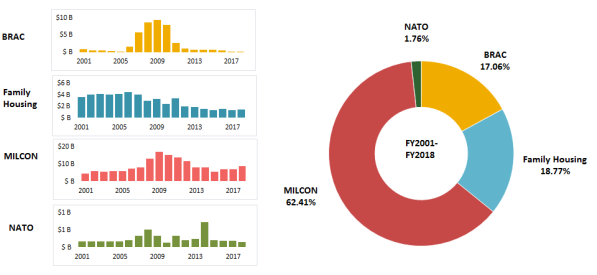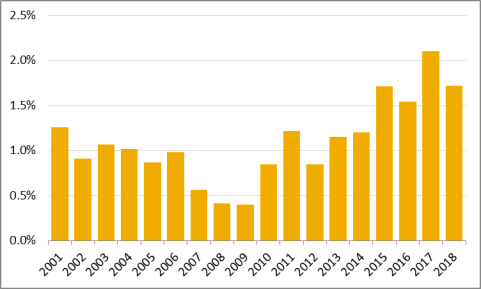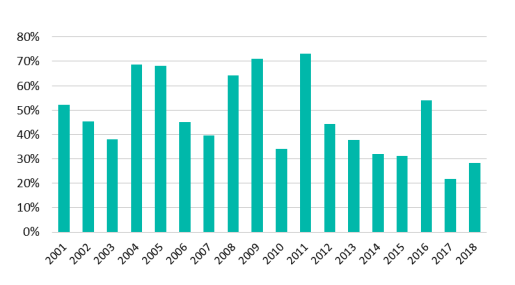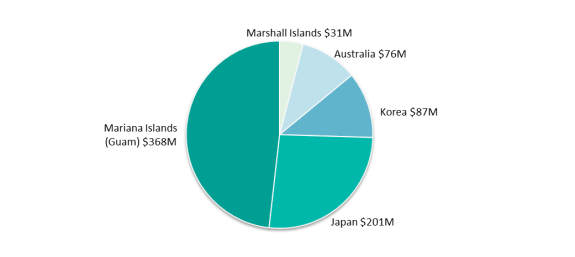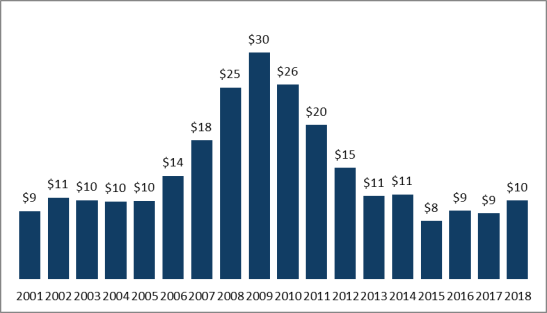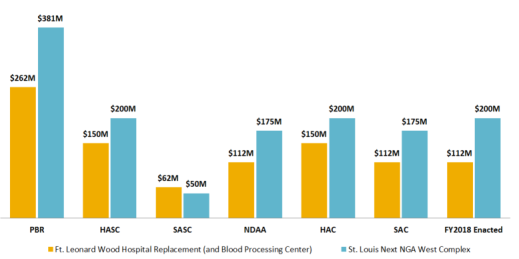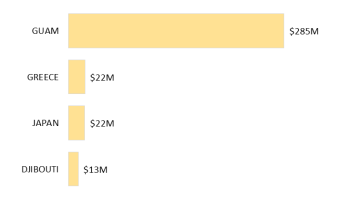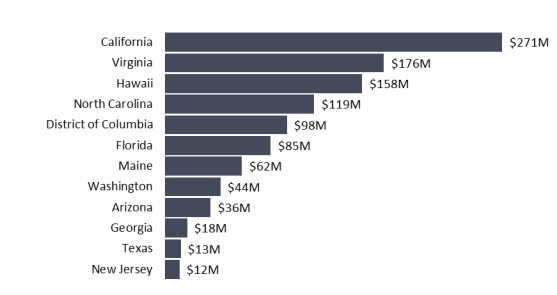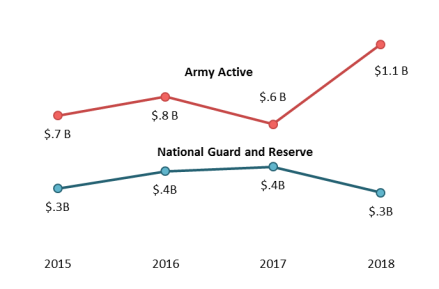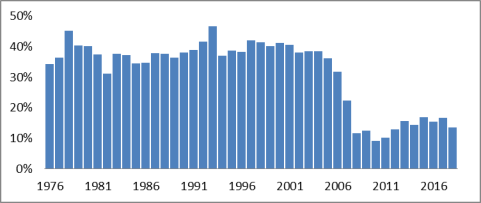Overview
The Military Construction, Veterans Affairs, and Related Agencies appropriations bill provides funding for the planning, design, construction, alteration, and improvement of Department of Defense (DOD) facilities used by active and reserve components worldwide. It capitalizes military family housing and the U.S. share of the NATO Security Investment Program, and finances the implementation of installation closures and realignments. It underwrites veterans benefit and health care programs administered by the Department of Veterans Affairs, provides for the creation and maintenance of U.S. cemeteries and battlefield monuments within the United States and abroad, and supports the U.S. Court of Appeals for Veterans Claims, Armed Forces Retirement Homes, and Arlington National Cemetery. The bill also funds construction supporting contingency military operations (i.e., Overseas Contingency Operations or OCO) and advance appropriations for veterans' medical services.
Administration's FY2018 Budget Request
On May 23, 2017, the Trump Administration delivered its first budget proposal to the 115th Congress, a request that included $646.9 billion for Department of Defense Military (051) spending.1 Of this amount, the Administration requested $9.8 billion for military construction and family housing in the base budget, and $0.6 billion in OCO funds, for a total of $10.4 billion. The proposal represented a substantial increase over FY2017 enacted totals.
DOD's requested increase in military construction funds would continue an upward trend that began in FY2015. The department indicated it would use the additional amounts in FY2018 to address key priorities that include the bed-down of new missions (such as the arrival of Joint Strike Fighters at various locations); support to Geographic Combatant Commands (GCCs) (e.g., improvements to existing air bases); medical facility recapitalization (at Fort Bliss, Fort Leonard Wood, Walter Reed, and Rhine Ordnance Barracks); and quality of life improvements (e.g., the replacement of DOD schools).2
The Administration's FY2018 topline request for defense appropriations was amended a number of times since its original submission and included $920 million dollars in additional funding. Not all of the changes altered the MILCON topline. They include
- June 2017: Additional justification materials provided to Congress for Air Force projects related to KC-46A Main Operating Base construction at Travis Air Force Base, CA and Joint Base McGuire Dix Lakehurst, NJ. The original request included a single line item ($269 million) for all 15 projects.
- Result: Early committee documents refer to the KC-46A as a single line item, while later ones itemized by project after deducting the original amount from the Administration's request.
- June 29, 2017: Administration request to amend Procurement, RDT&E, and Defense-Wide General Provisions accounts in order to more accurately reflect Administration policies and insert appropriations language that was inadvertently omitted in the original submission.3
- Result: These changes did not affect the Military Construction appropriation.
- November 6, 2017: Request for $202 million in additional funds primarily to support "urgent missile defeat and defense enhancements to counter the threat from North Korea."4 (Referred to by DOD as the missile amendment in Comptroller budget documents.)
- Result: Congress included an additional $200 million for this purpose in P.L. 115-96, the third of five Continuing Resolutions enacted in FY2018.
- November 17, 2017: Request for $721 million in additional funds to support hurricane recovery efforts in Puerto Rico and the U.S. Virgin Islands (second supplemental request).5 This request was received after the NDAA conference committee concluded its deliberations and the FY2018 bill (H.R. 2910, Title X) submitted to the President.
- Result: Congress fully funded this supplemental request in H.R. 1892 (P.L. 115-123), the fourth extensions of the CR, Division D of H.R. 601.6
|
Figure 1. Changes to the Administration's Original FY2018 MILCON Request (2017 Date of Congressional Notification) |
 |
|
Source: CRS Graphics. |
Most of the additional amounts for military construction activities the Administration requested in its November 17, 2017, Hurricane Recovery request would fund the reconstruction of a dozen Army National Guard facilities in Puerto Rico and the U.S. Virgin Islands that sustained heavy storm damage ($519 million) during the recent hurricane season.7 The remaining amounts would be for Navy construction at NAS Key West, FL and NAS Corpus Christi, TX ($202 million), military installations that also sustained storm related damage.
A related provision in the FY2018 NDAA (P.L. 115-91), as passed by both houses, would require the Secretary of Defense to provide congressional defense committees an assessment of hurricane damage to DOD assets.8
Overview of Congressional Action
The Military Construction, Veterans Affairs and Related Agencies Appropriations Act is typically among the least controversial of the defense-related appropriations bills Congress considers, due to rules in each chamber prohibiting the introduction of earmarks.9 For FY2018, congressional committees recommended altering the Administration's MILCON request by less than 4% overall.
|
Figure 2. FY2018 Military Construction (In billions of dollars) |
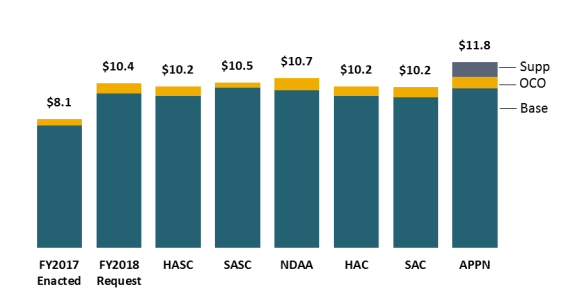 |
|
Sources: H.Rept. 115-200, S.Rept. 115-125, H.Rept. 115-188, S.Rept. 115-130, and Joint Explanatory Statement to accompany H.R. 1625. Notes: The column designation APPN throughout this report indicates final FY2018 appropriated amounts, as enacted. In the figure above, APPN also includes amounts provided in separate legislation for the Administration's emergency request for construction of 20 additional missile silos in support of the Ballistic Missile Defense System (BMDS) at Fort Greely, AK ($200 million) and additional Hurricane Supplemental appropriations ($519 million for the ARNG; $202 for the N/MC). |
Despite the relatively small topline changes to the Administration's request, congressional defense committees (House Armed Services Committee, or HASC; Senate Armed Services Committee, or SASC; House Appropriations Committee, or HAC; and Senate Armed Services Committee, or SAC) were not always in agreement about how to reshape military construction funding, particularly within the OCO account.
Table 1. Military Construction Funding, by Congressional Action and Account Type
(In millions of dollars)
|
FY17 Enact. |
FY18 Req. |
HASC |
SASC |
NDAA |
HAC |
SAC |
APPN |
Supp. |
|||
|
Title I (Base) |
$7,726 |
$9,782 |
$9,585 |
$10,145 |
$9,981 |
$9,585 |
$9,536 |
$10,091 |
$921 |
||
|
Military |
$5,724 |
$7,966 |
$7,781 |
$8,415 |
$8,129 |
$7,389 |
$7,253 |
$7,478 |
$921 |
||
|
Family |
$1,276 |
$1,407 |
$1,361 |
$1,335 |
$1,407 |
$1,407 |
$1,409 |
$1,409 |
$0 |
||
|
Admin. |
$307 |
$0 |
$0 |
-$15 |
$0 |
$321 |
$464 |
$717 |
$0 |
||
|
BRAC |
$240 |
$256 |
$291 |
$256 |
$291 |
$291 |
$256 |
$310 |
$0 |
||
|
NATO |
$178 |
$154 |
$153 |
$154 |
$154 |
$178 |
$154 |
$178 |
$0 |
||
|
Title IV (OCO) |
$420 |
$638 |
$637 |
$331 |
$749 |
$638 |
$638 |
$750 |
$0 |
||
|
Admin. |
$-12 |
$0 |
$0 |
$0 |
$0 |
$0 |
$0 |
$0 |
$0 |
||
|
ERI |
$126 |
$307 |
$195 |
$0 |
$343 |
$195 |
$307 |
$308 |
$0 |
||
|
OCO |
$306 |
$331 |
$442 |
$331 |
$406 |
$443 |
$331 |
$442 |
$0 |
||
|
Total |
$8,146 |
$10,421 |
$10,222 |
$10,476 |
$10,729 |
$10,223 |
$10,174 |
$10,841 |
$921 |
||
Source: H.Rept. 115-200, S.Rept. 115-125, H.Rept. 115-188, S.Rept. 115-130, and Joint Explanatory Statement to accompany H.R. 1625.
Notes: The column designation APPN throughout this report indicates final FY2018 appropriated amounts. SUPP indicates all supplemental and emergency requests. The table uses CRS defined account type categories (described in the Appendix) to adjust for variations among committee reports.
Among the congressional defense committees, the SASC was unique for recommending authorization of $56 million over the Administration's request, while other defense committees recommended an overall decrease of between $199-247 million. The SASC also shifted roughly half of the Administration's Overseas Contingency Operations funds—primarily for European Reassurance Initiative projects—from OCO into the base account.
|
Figure 3. FY2018 Overseas Contingency Operations MILCON Funding (In millions of dollars) |
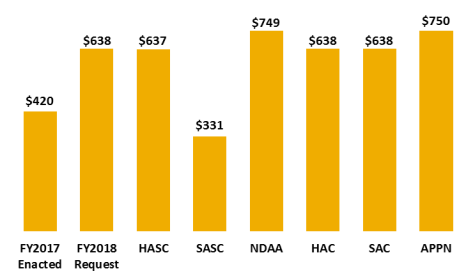 |
|
Source: H.Rept. 115-200, S.Rept. 115-125, H.Rept. 115-188, S.Rept. 115-130, and Joint Explanatory Statement to accompany H.R. 1625. Notes: The column designation APPN throughout this report indicates final FY2018 appropriated amounts, as enacted. The designation omits the Administration's emergency and supplemental requests unless otherwise specified. |
Authorization Actions
House Authorization
On July 14, 2017, the House of Representatives passed its version of the National Defense Authorization Act for FY2018 (H.R. 2810), which would have authorized $10.2 billion in appropriations for military construction, family housing, and base closure activities for the FY2018 year, roughly $199 million less than the Administration requested. Of this amount, $9.6 billion would have been authorized for base appropriations and an additional $637 million for the purposes of Overseas Contingency Operations.10
In FY2018 the House did not create a designation in its version of the NDAA that would have provided funding for a separate Military Construction for Overseas Contingency Operations for Base Requirements account, as it did in FY2017.11
Senate Authorization
On September 18, 2017, the Senate passed its version of the FY2018 NDAA (H.R. 2810). Before final passage, the content of the House bill was replaced by the text of the original Senate measure reported by the committee on Armed Services (S. 1519).
Division B of the bill would have authorized $10.5 billion in appropriations for military construction, family housing, and base closure activities for FY2018. Of this amount, $331 million was designated for Overseas Contingency Operations.
The Senate's version of the bill (S. 1519, or H.R. 2810 as amended) would have altered the Administration's topline request by authorizing an additional $56 million overall and shifting roughly half of OCO funds to the base account.
NDAA Conference Outcome and Presidential Signature
FY2018 NDAA conference negotiations concluded on November 8, 2017.12 The final bill, H.R. 2810, was subsequently passed by the House on November 14, 2017, and by the Senate on November 16, 2017. The bill was presented to the President on November 30, 2017, and two weeks later, on December 12, 2017, the bill was signed and enacted as P.L. 115-91.
P.L. 115-91 authorized $10.7 billion for military construction, family housing, and Base Realignment and Closure activities, or roughly $309 million more than the President's Budget Request (PBR).
During the course of the final NDAA conference negotiations, the President's Budget Request (PBR) was adjusted upward by $200 million in response to a November 6, 2017, supplemental request (missile amendment) by the Administration to "support urgent missile defeat and defense enhancements to counter the threat from North Korea."13
Shortly after passage of H.R. 2810 in both chambers, the Administration submitted an additional request for funds to support hurricane disaster relief operations. This hurricane supplemental (or hurricane relief) included $721 million for military construction activities that was not considered during the NDAA conference and, consequently, was not included in the final FY2018 NDAA (P.L. 115-91).
Appropriations Actions
House Appropriations
H.R. 3354, a 12-measure appropriations omnibus passed by the House on September 14, 2017, combined several bills. Originally considered as an eight-appropriations minibus, H.R. 3354 was amended to include the remaining four appropriations contained in a separate defense minibus, H.R. 3219, passed by the House in late July.
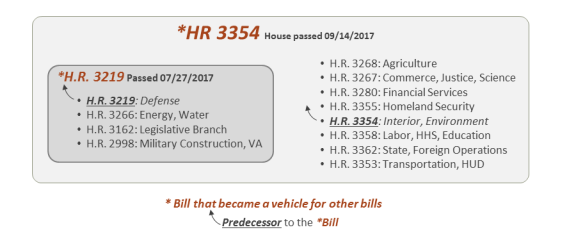 |
|
Source: CRS analysis of selected legislation. |
That defense minibus, H.R. 3219, included four bills. These were
- H.R. 2998: FY2018 Military Construction, Veterans Affairs, and Related Agencies Appropriations Act;14
- H.R. 3266: Energy and Water Development and Related Agencies Appropriations Act, 2018;
- H.R. 3219: Department of Defense Appropriations Act, 2018; and
- H.R. 3162: Legislative Branch Appropriations Act, 2018.
H.R. 3219, passed by the House on July 27, 2017, retained the number assigned to the defense appropriations bill contained in the act and was referred to as the "Make America Secure Appropriations Act", 2018.15 Division C of the omnibus included the original text of the FY2018 Military Construction, Veterans Affairs, and Related Agencies Appropriations Act, (H.R. 2998), which was reported by the House Committee on Appropriations on June 15, 2017.
|
Figure 5. H.R. 3219: Make America Secure Appropriations Act (Defense Minibus) (As passed by the House on July 27, 2017) |
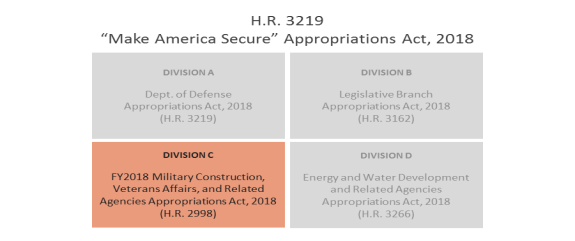 |
|
Source: CRS Graphics. |
Division C of H.R. 3219 would have appropriated $10.2 billion for military construction and family housing, within the jurisdiction of the House Appropriations Subcommittee on Military Construction, Veterans Affairs and Related Agencies.16 This amount would have represented $198 million less than the Administration requested. Funding for Military Construction projects is provided through Title I and Title IV of the Military Construction, Veterans Affairs, and Related Agencies Appropriations Act.17
Senate Appropriations
On July 13, 2017, the Senate Appropriations Committee unanimously approved passage of S. 1557, the Military Construction, Veterans Affairs, and Related Agencies Appropriations Act, 2018. The bill, as introduced in the Senate, would have appropriated $9.5 billion for military construction, family housing, and base realignment and closure activities, and an additional $638 million for Overseas Contingency Operations. These amounts represent $247 million less than the Administration requested—the largest decrease among all the defense committee recommendations.
Enacted Appropriations
On March 22, 2018, the House passed the Consolidated Appropriations Act of 2018 (H.R. 1625, P.L. 115-141), a legislative vehicle comprising the 12 appropriations bills Congress enacts on an annual basis. Division J of the omnibus, which makes appropriations for Military Construction Veterans Affairs, and Related agencies for FY2018, provided $10.1 billion for military construction in Title I (base account), and $750 million in Title IV (Overseas Contingency Operations, or OCO). The Senate passed the bill in the early hours of March 23, 2018, and the President signed it later the same day.
|
Figure 6. Status Table of Congressional Action for Military Construction |
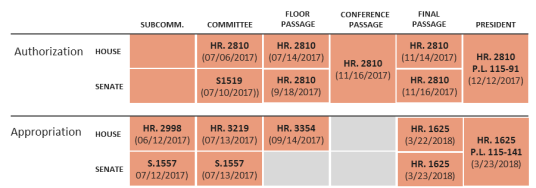 |
|
Source: CRS Graphics. |
Assessing the Military Construction Budget
This report is intended to summarize only the major elements of the Military Construction (MILCON) discretionary request. These include amounts provided for military construction activities (projects and planning), BRAC, and family housing. Since 2001, these totals are represented as slices in the pie chart below. The accompanying bar chart indicates the amounts of each element over time, as calculated by CRS.18
MILCON appropriations are composed almost entirely of discretionary funds.19 Though funding for facility capital expenses is primarily provided within MILCON, additional amounts (not covered in this report) are also distributed among separate appropriations for related purposes. For example, within the Operations and Management (O&M) account, significant funds are provided for the maintenance and repair of DOD facilities (Facilities Restoration, Sustainment and Management), for environmental cleanup (Environmental Restoration), for the disposal and leasing of DOD real property assets, and for Base Operations Support (BOS). Funding for military construction and maintenance of DOD research facilities can also be found within the Research Development, Test and Evaluation (RDT&E) appropriation.
Unspecified Minor Military Construction (UMMC)
Background
10 U.S.C §2805 authorizes the Secretary of Defense to use an expedited process for the authorization of unspecified minor military construction projects currently defined as a project costing $6,000,000 or less. Section 2805 requires the Secretary to fund such projects only with minor military construction appropriations except in cases where the total cost is less than $2 million, in which case the funds may be drawn from O&M appropriations.
Rather than including project level details in the Administration's annual military construction (MILCON) budget request, 10 U.S.C. §2805 authorizes the Secretary to initiate the authorization process by submitting a notification to defense committees independent of the President's budget submission. Following a 14-day waiting period, appropriations may then be drawn from an account set up by Congress in the MILCON appropriation for that purpose.
Administration's Request
Unspecified Minor Military Construction (UMMC) within the MILCON appropriation, on average, represents less than 2% of the total amount, or approximately $140 million. Since FY2012, the percentage has risen steeply relative to previous years, but has varied by small amounts as a proportion of the entire MILCON appropriation. The Administration requested approximately $180 million for minor construction in the FY2018 MILCON request.
Congressional Interest
The final effect of Congress' adjustments to UMMC notification time requirements and cost thresholds increase the Department's flexibility for undertaking larger UMMC projects while adjusting the burden of oversight for relatively small ones to the Secretary.20 H.R. 2810, as enacted, adjusts thresholds for U.S.C. 2805 as indicated by Table 2:
|
Threshold Purpose |
Current Threshold |
|
Qualifying project |
<=$6,000,000 |
|
Requires advance approval by Secretarya |
>$750,000 |
|
Requires Congressional notification and 14-day waiting period |
>$2,000,000 |
|
Authority to use O&M appropriations |
<=$2,000,000 |
|
Laboratory revitalizationb |
<=$6,000,000 |
|
Annual locality adjustmentsc |
<= $10,000,000 |
Source: 10 U.S.C. §2805 as amended by the FY2018 NDAA (P.L. 115-91).
Notes:
a. 10 U.S.C. §2805(b) specifies that advance approval is required for projects "carried out using funds made available to enhance the deployment and mobility of military forces and supplies."
b. 10 U.S.C. §2805(d) specifies the qualification criteria and congressional notification requirements for laboratory revitalization projects. See also 10 U.S.C. 2363—Mechanisms to provide funds for defense laboratories for research and development of technologies for military missions.
c. Section 2803 of FY2018 NDAA (P.L. 115-91) added 10 U.S.C. §2805(f). It requires the Secretary concerned to annually adjust the dollar limitations specified in 10 U.S.C. §2805 to reflect the area construction cost index for military construction (locality adjustment). The requirement expires in FY2022.
During NDAA conference negotiations, the Senate generally agreed to House-adjusted thresholds, but did not accept a change to the "life threatening" qualifier that Section 2802 would have removed from statute. The Senate also negotiated for an increase in the congressional notification threshold to $2 million.
Military Construction Activities, by Selected Regions
The following section summarizes military construction funding for projects in Europe and the Pacific based on the project location specified in DOD budget and justification documents. The purpose of this analysis is to identify capital investments in regions where DOD construction investments are most prominent.
Europe
In the Administration's FY2018 request, funding for the largest European construction projects was concentrated on projects in Germany (Rhine Ordnance Barracks Medical Center Replacement) and the United Kingdom (Royal Air Force Lakenheath for F-35A bed down). The majority of MILCON funding was distributed among projects in Northern and Western Europe.
|
Sub Region and Country |
Appropriations |
|
Eastern Europe |
$104.4 |
|
Hungary |
$55.4 |
|
Slovakia |
$46.0 |
|
Romania |
$3.0 |
|
Northern Europe |
$236.1 |
|
United Kingdom |
$193.6 |
|
Iceland |
$14.4 |
|
Estonia |
$13.9 |
|
Norway |
$10.3 |
|
Latvia |
$3.9 |
|
Southern Europe |
$152.3 |
|
Italy |
$112.1 |
|
Greece |
$40.1 |
|
Western Europe |
$382.9 |
|
Germany |
$315.5 |
|
Luxembourg |
$67.4 |
|
* Turkey |
$55.1 |
|
Total |
$930.7 |
Source: CRS Analysis, Compiled from DOD Comptroller, Military Construction, Family Housing, and Base Realignment and Closure Program (C-1).
Notes: Regional military construction activities are based on C-1 location data and the United Nations Standard country or area codes for statistical use (M49) geoscheme.21 Does not include a request of $154 million for NATO Security Investment program funds. Only includes FY2018 original request (not supplemental and emergency appropriated amounts).
* Turkey, a NATO member, is not included in the U.N. geoscheme.
In the Trump Administration's FY2018 budget request, military construction projects in Eastern Europe were funded by appropriations drawn from the European Reassurance Initiative (ERI) Overseas Contingency Operations account. A total of $104 million were directed to airfield improvements in Hungary ($55 million), Slovakia ($46 million), and Romania ($3 million) in support of Operation Atlantic Resolve.22
European Reassurance/European Deterrence Initiative (ERI/EDI)
The European Reassurance Initiative—first announced in 2014 by President Barack Obama during a trip to Warsaw, Poland—was originally intended to bolster the capacity of NATO partners against potential Russian aggression through persistent U.S. rotational presence, training, and military exercises.23 In the years since its introduction, the fund rapidly expanded both in size and scope, raising questions among some observers about the proper planning, management, and use of ERI funds for military infrastructure. Until FY2017, for example, DOD issued few project-level details about ERI construction.
During these early years, ERI MILCON appropriations were associated in budget documents with Worldwide Unspecified Location, the category usually associated with planning and design activities or unspecified minor construction. Several official investigations are now underway to assess the effectiveness of improvements to European partners' infrastructure.24 Congress has directed DOD to submit to the congressional defense committees a comprehensive military construction plan for future projects associated with ERI for each year the program remains active.25
The Pacific
Since FY2001, 44% of all spending for military construction projects (identified by project location) in PACOM's area of operations have been for the state of Hawaii. In the President's FY2018 request, Hawaii represents roughly 25% of all military construction projects located in PACOM.
Hawaii excluded, military construction spending within PACOM is consistently highest in Guam, Japan, and South Korea.
Following high level agreements between South Korea and the United States, the headquarters of U.S. Forces, Korea (USFK) and U.S. Army and Air Force units are being concentrated into two large military communities centered on Osan Air Base and Camp Humphreys, which are located south of the capital, Seoul. The U.S. and Japanese governments have also agreed on a significant relocation plan for American troops in Okinawa that would move operations at Marine Corps Air Station (MCAS) Futenma to a less-congested area of the island. As a result of the effort, roughly 9,000 Marines would be relocated from Japan to U.S. bases in Guam and elsewhere.
The Administration requested $763 billion for military construction projects within PACOM's area of operations (Hawaii excluded). The largest share (67%) of MILCON spending within PACOM would be directed to projects in support of the Marine relocations on Okinawa and Guam.26 A smaller share (11%) would fund family housing and aircraft facilities in South Korea. Fuel storage facilities for USAF KC-130 tanker aircraft in Darwin, Australia, represent 10% of the remainder.27
Military Construction Activities, by Military Department
DOD officials assert that since the implementation of the Budget Control Act of 2011 (P.L. 112-25), the services have significantly reduced MILCON spending and assumed increased risk in infrastructure.28 Budget data confirms the assertion that MILCON budgets have generally declined during this period (FY2013-FY2018), which corresponds to the end of a surge in 2005 Base Realignment and Closure (BRAC) spending.29
In a June 2017 hearing before the Senate Appropriations Subcommittee on Military Construction, Veterans Affairs, and Related Agencies, Acting Assistant Secretary of Defense (Energy, Installations, and Environment) Peter Potochney testified that DOD reductions to infrastructure investments have resulted in degraded facilities and "an unfunded backlog of deferred maintenance and repair (M&R) work that exceeds $140 billion, raising significant concerns about the performance and reliability of our facilities and installations."30
Potchney stated that though the Administration's FY2018 MILCON request represented a substantial increase over previous budget submissions, the total amount is "still insufficient to reverse the impacts to our facilities resulting from sequestration."31 The Administration's request of $10.4 billion for Military Construction appropriations represents a 28% increase over FY2017 enacted total of $8.1 billion.
Defense-Wide MILCON
This section provides an overview of the Administration's FY2018 Defense-Wide request for military construction projects, follows House and Senate action on selected line items, and summarizes final enacted totals. Unless otherwise specified, the amounts shown below combine both base (Title I) and OCO (Title IV).32
Administration's Request
The President proposed a total of $3.1 billion for the Defense-Wide account, an increase over FY2017 enacted levels. Though the Administration requested additional MILCON funds for each of the components in FY2018, it proposed adding the largest total amount—$1.3 billion—over FY2017 levels to the Defense-Wide account.33
More than half of the military construction activities in the Administration's defense-wide request were directed to projects in the states of Missouri ($643 million), Maryland ($438 million), California ($302 million), and Texas ($260 million), primarily for medical centers, national intelligence infrastructure, and special forces facilities.34
The two largest projects in the Administration's request were the replacement of a National Geospatial-Intelligence Agency (NGA) complex in St. Louis, MO ($381 million) and construction of a National Security Agency operations facility at Fort George G. Meade, MD ($314 million). Funding for NSA and NGA projects represent almost a quarter of the President's request.
Table 4. FY2018 Requested Defense-Wide Military Construction Funds , by Agency
(In millions of dollars and percentage)
|
Defense Agency |
FY2018 |
Percentage of Request |
|
Defense Health Agency |
$907.9 |
29.1% |
|
Special Operations Command |
$651.6 |
20.9% |
|
National Geospatial-Intelligence Agency |
$381.0 |
12.2% |
|
National Security Agency |
$353.0 |
11.3% |
|
Defense Logistics Agency |
$285.8 |
9.2% |
|
DOD Education Activity |
$283.4 |
9.1% |
|
Defense-Wide MILCON Program |
$186.5 |
6.0% |
|
Washington HQ Service |
$52.0 |
1.7% |
|
Joint Staff |
$11.5 |
0.4% |
|
Missile Defense Agency |
$3.0 |
0.1% |
|
Defense Information Systems Agency |
$1.2 |
0.0% |
|
Total |
$3,116.8 |
100.0% |
Source: CRS Analysis, Compiled from DOD Comptroller, Military Construction, Family Housing, and Base Realignment and Closure Program (C-1).
Medical facilities also represented a significant proportion of the Administration's FY2018 Military Construction Defense-Wide request. These included capital intensive hospital replacement projects at Fort Leonard Wood, MO ($262 million); Fort Bliss, TX ($260 million); Bethesda Naval Hospital, MD ($124 million; officially referred to as, "Walter Reed National Military Medical Center"); and Rhine Ordnance Barracks Medical Center, Germany ($107 million). Together, the Administration requested $0.9 billion in Defense Health Agency funding for the construction, planning and design of medical centers, hospitals, and clinics.
The defense-wide request included seven construction projects exceeding $100 million. The President also proposed Congress provide $150 million for the DOD's Energy Resilience Conservation and Investment Program (ERCIP), a strategic energy savings and modernization initiative.
Overview of Congressional Action
Congressional committees recommended reductions of between $300-500 million to the Administration's $3.1 billion Defense-Wide Military Construction request.35
|
Figure 12. FY2018 Military Construction in the Defense-Wide Account |
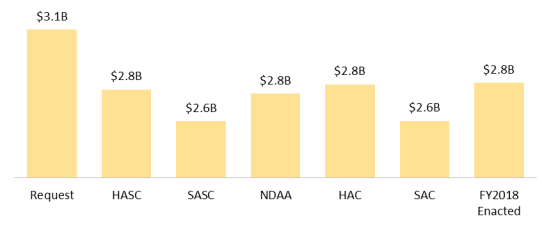 |
|
Sources: H.Rept. 115-200, S.Rept. 115-125, H.Rept. 115-188, S.Rept. 115-130, and Joint Explanatory Statement to accompany H.R. 1625. Notes: Amounts shown do not include the Administration's November amended request of an additional $200 million for construction of a Missile Field at Fort Greely, AK. Column heights indicate numerical differences that may not be reflected in totals shown, due to rounding. |
The committees primarily focused on reducing funding for projects in Missouri (Hospital Replacement at Fort Leonard Wood; NGA West Complex at St Louis) and Texas (Fort Bliss Hospital Replacement and associated blood processing center).36
Table 5. Congressional Funding Changes to Hospital Replacements Projects and Next NGA West Complex
(In millions of dollars)
|
Location |
Request |
HASC |
SASC |
NDAA |
HAC |
SAC |
APPN |
APPN |
|
MISSOURI |
$643 |
$-293 |
$-531 |
$-356 |
$-293 |
$-356 |
-$331 |
$312 |
|
Ft. Leonard |
$262 |
$-112 |
$-200 |
$-150 |
$-112 |
$-150 |
-$150 |
$112 |
|
St. Louis |
$381 |
$-181 |
$-331 |
$-206 |
$-181 |
$-206 |
-$181 |
$200 |
|
TEXAS |
$260 |
$-8 |
$0 |
$0 |
$-8 |
$-151 |
$0 |
$260 |
|
Ft. Bliss |
$260 |
$-8 |
$0 |
$0 |
$-8 |
$-151 |
$0 |
$260 |
|
Total |
$903 |
$-301 |
$-531 |
$-356 |
$-301 |
$-507 |
-$331 |
$572 |
Sources: H.Rept. 115-200, S.Rept. 115-125, H.Rept. 115-188, S.Rept. 115-130, and Joint Explanatory Statement to accompany H.R. 1625.
Note: The designation APPN indicates final appropriated amounts.
Several of the committees expressed concerns related to U.S. Army Corps of Engineers ability to manage such projects, and either reduced funding or implemented strict new reporting requirements that sought to establish stricter accountability and early corrections to cost overruns. For example, the Senate Armed Services report (S.Rept. 115-125) to accompany its version of the FY2018 NDAA (S. 1519) included the language
The committee is concerned with the number of construction projects that are experiencing significant schedule delays and cost increases. The recent notification that the Hospital at Fort Bliss, Texas would cost an additional $250.0 million because of ''omissions'' and ''design errors'' is just one example of poor management of these projects with little to no accountability for those responsible. With other significant projects planned, including a new facility for the National Geospatial Agency and a hospital replacement at Fort Leonard Wood, it is essential that the Secretary of Defense ensure the proper oversight and management of the U.S. Army Corps of Engineers and Navy Facilities Command and, if these organizations are not able to consistently deliver projects on budget and on schedule, seek alternatives. Therefore the committee recommends a number of provisions that would increase transparency on the causes and individuals responsible for significant cost increases and schedule delays and would advance contracting with outside organizations if problems continue.37
Authorization Actions
House Authorization
The House version of the National Defense Authorization Act for FY2018 (H.R. 2810) as passed on July, 14 2017, would have authorized $2.8 billion in funds for defense-wide construction projects in the base account, and an additional $.2 billion for Overseas Contingency Operations projects. This would have represented a decrease of $.3 billion from the Administration's requested total.38
Nearly all of the reductions in proposed project funding would have applied to two projects in Missouri; the construction of the Next NGA West Complex in Saint Louis (-$181 million), and the Fort Leonard Wood hospital replacement and associated blood processing center (-$112 million). In report language (H.Rept. 115-200), the House Armed Service Committee noted these changes were generally the result of its preference for providing funds only in amounts that could be obligated by agencies in the year of the authorization of appropriations.39
The House would also have shifted $22 million from the base defense-wide account to OCO for the purpose of constructing a fuel hydrant system at Naval Air Station Sigonella, Italy. This project would have represented the only significant defense-wide OCO construction project.
Senate Authorization
The Senate version of the National Defense Authorization Act for FY2018 (S. 1519) would have authorized $503 million less than the Administration's request of $3.1 billion for Defense-Wide Military Construction projects in the base and OCO accounts. The committee recommended shifting funds from the Defense-Wide account to other military departments, primarily the Navy.
Table 6. Senate Armed Services Proposed Changes to the Administration's Defense-Wide Requested Amount
(In millions of dollars)
|
Department |
Request |
SASC Change |
SASC Total |
|
Air Force |
$2,442 |
$92 |
$2,534 |
|
Army |
$1,344 |
$145 |
$1,489 |
|
Defense-Wide |
$3,117 |
$-503 |
$2,613 |
|
Navy |
$1,700 |
$408 |
$2,109 |
|
Total |
$8,604 |
$142 |
$8,746 |
Source: S.Rept. 115-125.
Note: NATO Security Investment Account ($154 million) omitted.
As in the House version of the FY2018 NDAA, the Senate proposed nearly all cuts be taken from two Missouri projects; the construction of the "Next NGA West Complex" in Saint Louis (-$331 million), and Fort Leonard Wood hospital replacement and associated blood processing center (-$200 million). The committee also recommended adding an additional $27 million to the President's Energy Resilience Conservation Investment Program (bringing the new total to $177 million), a comparatively large increase.40
Though Senate authorizers recommended fully funding the eighth increment of a hospital replacement facility and blood processing center at Fort Bliss, Texas, the committee stated its concern with ongoing design errors, cost over-runs, and management omissions. In a series of provisions the committee inserted new reporting requirements that would provide additional oversight. These included41
- Section 2831: Notification Requirement for Certain Cost Overruns and Schedule Delays;42
- Section 2832: Limited Authority for Private Sector Supervision of Military Construction Projects in Event of Extensive Overruns or Project Delays;43
- Section 2833: Annual Report on Cost Overruns and Schedule Delays;44 and
- Section 2834: Report on Design Errors and Omissions Related to Fort Bliss Hospital Replacement Project.45
NDAA Conference Outcome
The NDAA conference agreement authorized $2.96 billion for appropriations for base and OCO military construction activities, $151 million less than the Administration's requested amount.
Table 7. Selected NDAA Changes to the Administration's Defense-Wide Request
(In millions of dollars)
|
Request |
Change |
|
|
TITLE I - DEPARTMENT OF DEFENSE |
$813 |
$373 |
|
Construct Hydrant System (Sigonella, Italy) |
$22 |
-$22 |
|
Contingency Construction (Unspecified) |
$10 |
-$10 |
|
Energy Resilience Conservation Investment Program |
$150 |
$15 |
|
Hospital Replacement and Blood Processing Center (Fort Leonard Wood, MO) |
$262 |
-$150 |
|
** Missile Field #4 (Fort Greely, AK) |
$0 |
$200 |
|
Next NGA West (N2W) Complex (St. Louis, MO) |
$381 |
-$206 |
|
TITLE IV - OVERSEAS CONTINGENCY OPERATIONS |
$0 |
$22 |
|
Construct Hydrant System (Sigonella, Italy) |
$0 |
$22 |
|
Grand Total |
$813 |
-$151 |
Source: H.Rept. 115-404, Joint Explanatory Statement of the Committee of Conference.
Notes: Missile Field #4 was not part of the Administration's original request, but was added as a budget amendment following a November 6, 2017, letter to Congress from the President.46 Table indicates only those projects changed from the original request, and does not represent a comprehensive list.
NDAA conferees made the largest reductions to two Missouri projects—construction of a "Next NGA West Complex" in Saint Louis, and replacement of a hospital (and associated blood processing center) at Fort Leonard Wood. In report language, House and Senate conferees voiced support, but reiterated a preference for providing incremental funding only in amounts the managing agency would be able to execute in the year of the authorization of appropriations.47
In the end, the final agreement contained a provision (Section 2823) advanced by the Senate that requires a report on design errors and omissions that led to $245 million cost increase for a Fort Bliss, TX hospital replacement project (increment 8). The agreement fully funded the President's requested amount for FY2018 ($251 million).
Defense-Wide Missile Supplemental
On November 6, 2017, in response to provocative North Korean nuclear and ballistic missile tests, the Administration submitted to Congress an additional request for funds that included $200 million in the defense-wide account for the enlargement of a ground based ballistic missile defense system at Fort Greely, AK.48
During conference deliberations, House and Senate authorizers agreed to fully fund the new project. Conference managers also adjusted the President's Budget Request (PBR) in the final report (H.Rept. 115-404), adding the $200 million project that had not previously been considered by each of the committees. Unlike conference managers, throughout this report CRS has chosen to leave the original PBR unadjusted in order to allow for a more uniform comparison of legislative actions.
Appropriations Actions
House Appropriations
Division C of the House-passed defense omnibus H.R. 3219 would have appropriated $2.8 billion for Defense Wide Military Construction projects, a decrease of $0.3 billion from the Administration's requested total. Like House and Senate authorizers, House appropriators would have reduced funding primarily for two Missouri construction projects, the Next NGA West Complex in Saint Louis ($181 million), and Fort Leonard Wood Hospital and blood processing center ($112 million).
In report language, the House Committee on Appropriations expressed skepticism that the Defense Health Agency, which oversees the hospital construction at Fort Leonard Wood, would be able to obligate the full amount as requested in the year of the authorization of appropriations, owing to the large number of other ongoing projects the agency is managing.49 The committee also expressed similar concerns regarding the National Geospatial Intelligence Agency West Campus Headquarters project, citing unobligated funds from the previous year and an evaluation of Work-in-Progress (WIP) projections.50
Senate Appropriations
The Senate version of the Military Construction, Veterans Affairs, and Related Agencies Appropriations Bill for FY2018 (S. 1557) would have provided $2.6 billion for Defense-Wide military construction, roughly $0.5 billion less than the Administration's request. Of the reduced amount, more than half was taken from hospital replacement and blood processing centers projects in Fort Leonard Wood, MO and Fort Bliss, TX, with most of the remainder taken from a major NGA replacement complex in Saint Louis, MO.
Like House authorizers, Senate appropriators cited examples of Army Corps of Engineers (USACE) mismanagement:
These are two examples (Fort Bliss Hospital Replacement; Irwin Army Community Hospital at Fort Riley, Kansas) of a pattern of mismanagement and a lack of accountability from the Corps that raise questions about the cost estimates and the planned execution of major projects included in DHA's fiscal year 2018 budget request.... The Committee is not convinced that the $251,000,000 requested as the final increment for the Fort Bliss Hospital will, in fact, be the final increment.... 51
Senate appropriators were the only defense committee to recommend a large reduction for the Fort Bliss project above, providing $108 million of the requested $260 million in appropriations (a reduction of $151 million). However, they joined others in significantly reducing funds requested for the Hospital replacement project at Fort Wood, providing less than half of the Administration's request ($108 million of the requested $260 million).52
In contrast to the concerns expressed with the USACE, the committee described its reduction in funds provided for "Next NGA West" project ($175 million of $381 requested) as a reflection of a preference for incremental, rather than phased funding.
The work in progress curve submitted with the budget request shows that the NGA can only execute a fraction of the $381,000,000, and will not take possession of the required land until the 4th quarter of fiscal year 2018. The Committee believes this is a textbook example of a project that should be incrementally funded. Therefore, the Committee provides $175,000,000 for the first increment of this project.53
Enacted Appropriations
The FY2018 Military Construction appropriations bill (Division J. of P.L. 115-141) as enacted on March 23, 2018, provided $2.8 billion for Defense-wide base and OCO military construction projects, or $281 million less than the Administration's initial request. Among the largest changes the legislation made was a reduction from the President's request for several large Missouri projects; the "Next National Geospatial-Intelligence Agency (NGA) West Complex" in Saint Louis ($181 million),54 and Phase I of a hospital replacement project at Fort Leonard Wood ($150 million).55 These reduced amounts were generally consistent with the actions of both authorizing and appropriating defense committees. (See Figure 13)
Reflecting a common concern, appropriating committees adopted language in their joint explanatory statement about U.S. Army Corps of Engineers management of Defense Health Agency (DHA) construction projects:
Army Corps of Engineers projects within the Defense Health Agency. – The Army Corps of Engineers (the Corps) has an extremely large portfolio including executing Defense Health Agency (DHA) construction projects. There is great concern for cost overuns and poor execution of Corps projects. The Corps currently has 45 active DHA construction projects underway worldwide where there is a definitive need for effective and efficient project management. Therefore, the Acting Director of the Facilities Division within DHA is directed to provide quarterly reports to the congressional defense committees on the progress of all hospital construction projects to include any settlements that have been reached for contractor error or project management deficiencies.
Overall, appropriators made less than a dozen changes to the Administration's request of funding for more than 80 military construction projects. The table below summarizes these changes:
Table 8. Enacted Changes to the Administration's FY2018 Defense-Wide Request
(Base and OCO; in millions of dollars)
|
Project |
Request |
FY2018 Enacted |
Change |
|
|
TITLE 1 (Base) |
||||
|
St. Louis, MO |
Next NGA West (N2W) Complex |
$381.0 |
$200.0 |
-$181.0 |
|
Fort Leonard Wood, MO |
Hospital Replacement |
$250.0 |
$100.0 |
-$150.0 |
|
Sigonella, Italy |
Construct Hydrant System |
$22.4 |
$0.0 |
-$22.4 |
|
Contingency Construction |
(Account) |
$10.0 |
$0.0 |
-$10.0 |
|
Unspecified Minor |
(Account) |
$3.0 |
$13.0 |
$10.0 |
|
Energy Resilience |
(Account) |
$150.0 |
$165.0 |
$15.0 |
|
Planning and Design |
Energy Resilience Conservation Investment Program |
$0.0 |
$10.0 |
$10.0 |
|
Planning and Design |
Defense-Wide |
$23.5 |
$48.5 |
$25.0 |
|
TITLE IV (OCO) |
||||
|
Sigonella, Italy |
Construct Hydrant System |
$0.0 |
$22.4 |
$22.4 |
|
Changed Total |
-$281.0 |
|||
Source: Joint Explanatory Statement to accompany H.R. 1625.
Note: Note that funding for the project in Sigonella, Italy, was moved from Base to OCO without further changes.
Navy and Marine Corps
This following section provides an overview of the Administration's FY2018 Navy and Marine Corps request for military construction projects, follows House and Senate action on selected items, and summarizes final enacted totals.56 Unless otherwise specified, the amounts shown below combine both base (Title I) and OCO (Title IV).57 This section examines only those projects that qualify as project line items. The amounts shown generally do not include family housing, BRAC, or NATO accounts that have no associated location.
President's Request
The Administration requested a total of $1.7 billion for Navy and Marine Corps military construction projects for FY2018. This included funding in both the base and OCO accounts for the active (96% of the total) and reserve forces (4% of the total). The combined request remained generally consistent with enacted amounts since FY2013.
In testimony before the Senate Appropriations Subcommittee on Military Construction, Veterans Affairs and Related Agencies, Vice Admiral Dixon Smith, Deputy Chief of Naval Operations for Fleet Readiness and Logistics, stated the Navy has been "compelled to accept risk in the shore to support warfighter readiness." With its FY2018 request, he stated the Navy had omitted a number of high priority projects addressing operational requirements, improvements to utilities infrastructure, and unaccompanied housing projects.58
Major General John Broadmeadow, Commander, Marine Corps Installations Command and Assistant Deputy Commandant, Facilities, Installations and Logistics Department testified, "To maintain near-term operational readiness, the Marine Corps has been forced to accept risk in its infrastructure portfolio. Taking risk in the facilities sustainment, restoration and modernization, and military construction has resulted in the degradation of our infrastructure, which in turn increases lifecycle costs."59 The Marine Corps is implementing a service-wide Infrastructure Reset Strategy based on its conclusion that the current number of facilities "exceeds mission requirements and diverts resources from higher priorities."60
Outside of the United States, the largest share of the Navy and Marine Corp's FY2018 request would have funded projects at various locations on Guam, where the services are engaged in infrastructure improvements in support of the permanent relocation of USMC forces from Okinawa.61
Within the United States, Navy and Marine Corps construction in California would have accounted for nearly a quarter of all funding—$271 million—with the top three largest projects at Naval Air Station Lemoore, Camp Pendleton, and Twentynine Palms, CA.
Other significant investments for the Navy and USMC would have ncluded the construction of a large water treatment plant and bachelor enlisted quarters at Camp Lejeune, NC ($104 million), and land purchases and laboratory restoration at Naval Support Activity Washington, DC ($97 million).
Overview of Congressional Action
With the exception of the SASC, congressional defense committees recommended relatively few alterations to the Administration's $1.7 billion request for military construction activities for the Navy and Marine Corps in FY2018. SASC would have added a comparatively large number of new projects to the active service but increased the Navy and Marine Corp's topline military construction project request by only $0.4 billion.
All committees agreed on a significant reduction for a Navy Support Activity (NSA) Washington, DC land acquisition project ($60 million requested), which is seeking to acquire four acres at the Washington Navy Yard as a security buffer and, possibly, a site to which the Navy could relocate the National Museum of the U.S. Navy, which because of Navy Yard security measures since the 2013 shooting at building 197, has seen a significant drop in visitors. There was no similar consensus on altering other specific projects.
|
Figure 16. FY2018 Navy and Marine Corps Construction Activities |
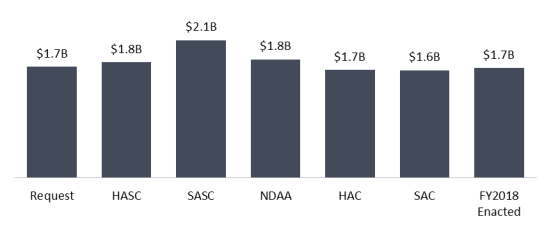 |
|
Sources: H.Rept. 115-200, S.Rept. 115-125, H.Rept. 115-188, S.Rept. 115-130, and Joint Explanatory Statement to accompany H.R. 1625. Notes: BRAC, Family Housing, and NATO accounts not included. Column heights indicate numerical differences that may not be reflected in totals shown due to rounding. |
Authorization Actions
House Authorization
The House version of the National Defense Authorization Act for FY2018 (H.R. 2810) would have authorized $1.8 billion, an increase of $0.7 billion for Navy and Marine Corps military construction above the amount the Administration requested. Most of this increase was for unfunded projects in California and Georgia.62
Table 9. HASC Changed: Navy Military Construction Activities (by State/Country)
(In millions of dollars)
|
State, Location, Project |
Requested |
HASC Change |
|
TITLE I - DEPARTMENT OF DEFENSE |
||
|
CALIFORNIA |
$0 |
$84 |
|
Marine Corps Air Station Miramar |
|
|
|
F-35 Simulator Facility |
$0 |
$48 |
|
Coronado |
|
|
|
P988 Undersea Rescue Command Ops Building |
$0 |
$36 |
|
DISTRICT OF COLUMBIA |
$60 |
$-45 |
|
NSA Washington |
$60 |
$-45 |
|
DJIBOUTI |
$13 |
$-13 |
|
Camp Lemonier |
$13 |
$-13 |
|
GEORGIA |
$0 |
$43 |
|
Marine Corps Logistics Base Albany |
|
|
|
Combat Vehicle Warehouse |
$0 |
$43 |
|
Worldwide Unspecified |
$0 |
$-10 |
|
TITLE IV - OVERSEAS CONTINGENCY OPERATIONS |
||
|
DJIBOUTI |
$0 |
$13 |
|
Camp Lemonier |
$0 |
$13 |
|
Total |
$73 |
$72 |
Source: H.Rept. 115-200.
H.R. 2810, as passed on July 14, 2017, would also have made some offsetting cuts to projects the Administration requested in Djibouti (Camp Lemonier, $13 million) and at the Washington Navy Yard, in the District of Columbia ($45 million).63
Senate Authorizations
The Senate version of the FY2018 NDAA (S. 1519), as reported by committee on June 28, 2017, would have added $0.4 billion to the Administration's $1.7 billion request, for a total of $2.1 billion. The additional amount was the largest proposed increase in the Navy and Marine Corps military construction account among all congressional defense committees.
The SASC proposed cutting funding for one item: a land acquisition project at the Washington, DC, Navy Yard. The committee recommended omitting all funding ($60 million) for the project without written comment. The committee would also have shifted $18.5 million of OCO-designated funds for ERI planning and design into the base account, with no net decrease for the Department of the Navy.
Most of the additional funds ($459 million) the committee recommended were for projects in California, Florida, and North Carolina that were not included in the Administration's original request. More than half were for projects listed in the Navy's unfunded priority list, including $110 million in funds for Littoral Combat Ship support and training facilities at Mayport, FL.
Other committee additions included funds for a modernized pier in San Diego ($108 million) and for construction of a radio operations complex for the Marine Corps.64
|
State/Project |
Amount |
|
Navy Unfunded Priority List (UPL) |
$254 |
|
CALIFORNIA |
$144 |
|
P440 Pier 8 Replacement |
$108 |
|
P988 Undersea Rescue Command (URC) Operations Building |
$36 |
|
FLORIDA |
$110 |
|
P426 Littoral Combat Ship (LCS) Support Facility (LSF) |
$81 |
|
P427 Littoral Combat Ship (LCS) Training Facility (LTF) |
$29 |
|
SASC Added Projects (Not UPL) |
$205 |
|
CALIFORNIA |
$48 |
|
F-35 Simulator Facility |
$48 |
|
GEORGIA |
$43 |
|
Combat Vehicle Warehouse |
$43 |
|
HAWAII |
$26 |
|
Mokapu Gate Entry Control AT/FP Compliance |
$26 |
|
NORTH CAROLINA |
$64 |
|
Radio BN Complex, Phase 2 |
$64 |
|
VIRGINIA |
$24 |
|
TBS Fire Station Building 533 Replacement |
$24 |
|
Total Added Amount |
$459 |
Source: S.Rept. 115-125.
Notes: Does not include $79 million in reductions at two project locations: Washington Navy Yard ($60 million), and planning and design activities designated as Worldwide Unspecified ($19 million).
NDAA Conference Outcome
The NDAA conference agreement authorized $1.8 billion for military construction activities for the Navy and Marine Corps, or $117 million more than the Administration requested. The agreement
- Authorized additional amounts for six projects not included in the Administration's budget request;
- Shifted funding from the base to the OCO account for aircraft parking apron expansion at Camp Lemonier, Djibouti; and
- Eliminated all funding for the construction of additional force protection measures at the Washington Navy Yard in the District of Columbia ($60 million).
Table 11. NDAA Changes to the Administration's Navy Military Construction Request
(In millions of dollars)
|
Project |
Requested |
NDAA Change |
|
TITLE I - DEPARTMENT OF DEFENSE |
$73 |
$104 |
|
F-35 Simulator Facility (Marine Corps Air Station Miramar, CA) |
$0 |
$48 |
|
Combat Vehicle Warehouse (Marine Corps Logistics Base Albany, GA) |
$0 |
$43 |
|
P988 Undersea Rescue Command (URC) Operations Building (Coronado, CA) |
$0 |
$36 |
|
Mokapu Gate Entry Control AT/FP Compliance (Marine Corps Base Kaneohe Bay, HI) |
$0 |
$26 |
|
TBS Fire Station Building 533 Replacement (Marine Corps Base Quantico, VA) |
$0 |
$24 |
|
Aircraft Parking Apron Expansion (Camp Lemonier, Djibouti) |
$13 |
-$13 |
|
Washington Navy Yard AT/FP (NSA Washington, DC) |
$60 |
-$60 |
|
TITLE IV - OVERSEAS CONTINGENCY OPERATIONS |
$0 |
$13 |
|
Aircraft Parking Apron Expansion (Camp Lemonier, Djibouti) |
$0 |
$13 |
|
Total Change |
$73 |
$117 |
Source: H.Rept. 115-404, Joint Explanatory Statement of the Committee of Conference.
The final legislation most closely resembled House changes to the Administration's request. Only one item the HASC had altered was not included in the final agreement (prior year savings, $10 million). In contrast, the Senate altered six projects ($291 million) that were not included in the final conference agreement. Most of these amounts were for Littoral Combat Ship support and training facilities at Mayport, FL ($110 million) and a replacement pier in San Diego, CA ($108 million).
Appropriations Actions
House Appropriations Committee Actions
House appropriators generally left the Administration's Navy and Marine Corps construction request unaltered. H.R. 2998, as reported out of the committee (later included in the defense omnibus H.R. 3219 as Division C), decreased the Navy's topline request by $45 million, affecting a single Navy/Marine Corps military construction project.65
This project, a land acquisition proposal at Naval Support Activity Washington, received little support among the congressional defense committees for FY2018. In project documents, the Navy described the four acres to be purchased as part of a plan to buffer critical assets at the northwest corner of Washington Navy Yard from explosive attacks, surveillance, and encroachment. The parcel might also have been used as a new location for the National Museum of the U.S. Navy.66 In similar action to other congressional committees, House appropriators recommended reducing the Navy's $60 million requested amount to $15 million.
Senate Appropriations Committee Actions
S. 1557, as reported on July 13, 2017, would have provided $1.6 billion in appropriations for Navy and Marine Corps military construction projects in FY2018. This represented $51 million less than the Trump Administration's requested total.
Like House appropriators, the Senate bill left the Administration's Navy and Marine Corps request for military construction projects virtually unchanged. S. 1557 would have altered only two projects. First, it would have omitted the entire amount requested for the land acquisition project at Naval Support Activity (NSA) Washington, DC. Second, the bill would have added $9 million for planning and design efforts at unspecified worldwide locations.
Enacted Appropriations
In the enacted FY2018 Military Construction appropriations bill, Congress appropriated $1.7 billion for military construction Navy and Marine Corps projects, reducing the Administration's topline request by $18 million, or roughly 1%. These cuts were taken primarily from the Navy active forces, with the Navy Reserve receiving an additional $30 million over requested amounts for minor construction ($10 million) and planning and design ($20 million).
The largest single change the legislation made to the Administration's request was a reduction by $60 million—the entire amount requested—for a land acquisition project at the Naval Support Activity (NSA) Washington Navy Yard, in Washington D.C, for the purpose of creating a security buffer zone around existing facilities and possibly, a new National Museum of the U.S. Navy. The cut reflected both House and Senate skepticism of the project as submitted; Senate appropriators provided $14 million for the $60 million project, while Senate appropriators cut funding for the project entirely.
The legislation also adopted a change made by House appropriators that shifted from base to OCO the full $13 million in requested funds for an expansion of an airfield in Camp Lemonier, Djibouti, a site that supports operations in the Horn of Africa and throughout the region.67
The following table summarizes military construction project funds appropriated for the Navy and Marine Corps, by location.
Table 12. FY2018 Enacted Appropriations for the Navy and Marine Corps
(In millions of dollars and percentage)
|
Project Location |
FY2018 Enacted |
Percentage of Total |
|
Worldwide Unspecified |
$308.7 |
18.36% |
|
Guam |
$284.7 |
16.93% |
|
California |
$270.5 |
16.09% |
|
Virginia |
$175.9 |
10.46% |
|
Hawaii |
$158.1 |
9.40% |
|
North Carolina |
$119.4 |
7.10% |
|
Florida |
$84.8 |
5.04% |
|
Maine |
$61.7 |
3.67% |
|
Washington |
$44.4 |
2.64% |
|
District of Columbia |
$37.9 |
2.25% |
|
Arizona |
$36.4 |
2.16% |
|
Greece |
$22.0 |
1.31% |
|
Japan |
$21.9 |
1.30% |
|
Georgia |
$17.8 |
1.06% |
|
Djibouti |
$13.4 |
0.80% |
|
Texas |
$12.6 |
0.75% |
|
New Jersey |
$11.6 |
0.69% |
|
Total |
$1,681.8 |
100.00% |
Source: Joint Explanatory Statement to accompany H.R. 1625.
Army
This following section provides an overview of the Administration's FY2018 Army request for military construction projects, follows House and Senate action on selected items, and summarizes final enacted totals. Unless otherwise specified, the amounts shown below combine both base (Title I) and OCO (Title IV).68 This section examines only those projects that qualify as project line items. The amounts shown generally do not include family housing, BRAC, or NATO accounts that have no associated location.
President's Request
The Administration requested $1.3 billion in FY2018 for Army military construction projects. Unlike the Navy, the Army proposed a limited number of capital intensive projects while more evenly distributing its military funding request across a wide number of locations.
FY2018 marked the third consecutive year the Army's MILCON request was the smallest among all services. DOD estimated that 22% of Army facilities were in poor or failing condition, as a result of regularly prioritizing readiness and other operational areas over infrastructure.69
With its FY2018 MILCON request, the Army stated that it would focus on "replacement of poor and failing training, operations and maintenance facilities, cyber capability facility deficits, footprint consolidation, and construction of new facilities for the National Guard and Reserves."70 For FY2018, the Army proposed MILCON investments primarily in the active component, while reducing MILCON investments for new National Guard and Reserve facilities.
Roughly 10% ($115 million) of the Army's FY2018 request was for the construction of austere barracks for unaccompanied enlisted personnel assigned to Joint Task Force-Guantanamo (JTF GTMO) in support of the detention mission at Guantanamo Bay, Cuba.71 Other projects included a third increment of funding for a new U.S. Army Pacific Command and Control Facility at Fort Shafter, HI ($90 million of a total estimated $370 million overall cost), and the construction of military incarceration facility at Joint Base Lewis-McChord, WA ($66 million).72
Overview of Congressional Action
Authorizers and appropriators generally proposed funds for Army construction (including Reserve and Guard) that met or exceeded the Administration's request.
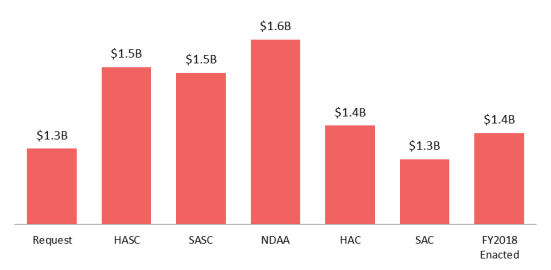 |
|
Source: H.Rept. 115-200, S.Rept. 115-125, H.Rept. 115-188, S.Rept. 115-130, and Joint Explanatory Statement to accompany H.R. 1625. Notes: Includes Army Active, Reserve, and National Guard authorizations in the base and OCO accounts. Column heights indicate numerical differences that may not be reflected in totals shown due to rounding. |
Authorizers added substantial amounts to a number of projects, including additional amounts for unfunded reserve and guard construction. Generally, appropriators avoided making significant changes, altering only a few projects at specified locations. There was no consensus on altering any specific Army project.
Authorization Actions
House Authorization
H.R. 2810, the House version of the National Defense Authorization Act for FY2018, would have authorized $1.5 billion in appropriated amounts for Army military construction, an increase of $156 million over the Administration's request.
Most of the new amounts would have been directed to unfunded Army National Guard ($56 million) and Reserve ($56 million) projects. Among these, the largest single increase would have provided $32 million in funds for an Army National Guard aircraft maintenance hangar in Springfield, MO. Other comparable increases included $30 million for an Army Reserve center at Joint Base Lewis-McChord, WA, and $26 million for the construction of an Army Reserve center training building in Aguadilla, Puerto Rico.73
Table 13. HASC Proposed Changes to Army Military Construction Activities in the FY2018 Request
(In millions of dollars)
|
Service, Installation, Project Title |
Request |
HASC Changed |
HASC |
|
ARMY, ACTIVE |
|||
|
Fort Hood, TX |
$0 |
$33 |
$33 |
|
Vehicle Maintenance Shop |
$0 |
$33 |
$33 |
|
Fort Benning, GA |
$0 |
$11 |
$11 |
|
Air Traffic Control Tower (ATCT) |
$0 |
$11 |
$11 |
|
Minor Construction |
$32 |
$10 |
$42 |
|
Turkey Various |
$6 |
$0 |
$6 |
|
Planning and Design |
$0 |
-$10 |
-$10 |
|
Prior Year Savings: Unspecified Minor Construction |
$0 |
-$10 |
-$10 |
|
ARMY NATIONAL GUARD |
|||
|
Springfield, MO |
$0 |
$32 |
$32 |
|
Aircraft Maintenance Hangar (Addition) |
$0 |
$32 |
$32 |
|
Fort Belvoir, VA |
$0 |
$15 |
$15 |
|
National Guard Readiness Center |
$0 |
$15 |
$15 |
|
Mission Training Center Gowen, ID |
$0 |
$9 |
$9 |
|
Enlisted Barracks, Transient Training |
$0 |
$9 |
$9 |
|
ARMY RESERVE |
|||
|
Joint Base Lewis-McChord, WA |
$0 |
$30 |
$30 |
|
Army Reserve Center |
$0 |
$30 |
$30 |
|
Fort Buchanan, Puerto Rico |
$0 |
$26 |
$26 |
|
Reserve Center |
$0 |
$26 |
$26 |
|
Total |
$38 |
$156 |
$194 |
Source: H.Rept. 115-200
For the Active forces, the committee recommended an additional $33 million for the construction of a vehicle maintenance shop in Fort Hood, Texas, bringing the adjusted project total to $47 million. The committee recommended shifting $6 million in funds from the Base to the OCO account for various facilities in Turkey that would have provided support for the AN/TPY-2 radar system, a deployed component of the Missile Defense Agency (MDA).74
Senate Authorization
The Senate version of the FY2018 NDAA (S. 1519) would have authorized $1.5 billion in appropriations for Army MILCON, an increase of $145 million over the President's request. Like House authorizers, the Senate's bill would have provided funds for eight previously unfunded Reserve and Guard projects.75
The table below indicates only those projects altered by the committee from the Administration's request.
Table 14. SASC Changed Army Military Construction Projects in the FY2018 Request
(In millions of dollars)
|
Requested |
Changed |
SASC |
|
|
ARMY, ACTIVE |
|||
|
Fort Hood, TX |
$0 |
$33 |
$33 |
|
Pohakuloa Training Area, HI |
$0 |
$25 |
$25 |
|
Fort Benning, GA |
$0 |
$11 |
$11 |
|
Worldwide Unspecified |
$16 |
$0 |
$16 |
|
Joint Base Lewis-McChord, WA |
$66 |
-$66 |
$0 |
|
ARMY NATIONAL GUARD |
|||
|
Springfield, MO |
$0 |
$32 |
$32 |
|
Fort Leavenworth, KS |
$0 |
$19 |
$19 |
|
Fort Belvoir, VA |
$0 |
$15 |
$15 |
|
Mission Training Center Gowen, ID |
$0 |
$9 |
$9 |
|
Camp Dodge, IA |
$0 |
$9 |
$9 |
|
ARMY RESERVE |
|||
|
Joint Base Lewis-McChord, WA |
$0 |
$30 |
$30 |
|
Newark, DE |
$0 |
$20 |
$20 |
|
Wright-Patterson AFB, OH |
$0 |
$9 |
$9 |
|
Total |
$82 |
$145 |
$227 |
Source: S.Rept. 115-125
Note: Table does not contain $16 million of ERI Planning and Design funds that were shifted by the SASC from the OCO to the Base account.
While the Senate bill included some additional amounts for unfunded projects for the Army active component, the greatest single change S. 1519 would have made to the Administration's request was the elimination of $66 million for a medium security confinement facility for the incarceration of military prisoners at Joint Base Lewis-McChord, WA.76 Other changes would have provided amounts for unfunded projects that include a vehicle maintenance shop in Fort Hood, TX ($33 million); and support for the construction of a barracks at Pohakuloa Training Area, HI ($25 million).
NDAA Conference Outcome
The NDAA conference agreement authorized $1.6 billion in base and OCO military construction appropriations for the Army Active, Guard, and Reserve components. The total amounts represented $208 million more than the Administration requested, with most of the additional funds provided for relatively small projects valued at less than $35 million in the base account for the Guard and Reserve. The final authorized amount for all Army construction exceeded funds authorized by both the House and Senate prior to conference.
|
Request |
House Changed |
Senate Changed |
NDAA Changed |
Final NDAA |
|
$1,344 |
$156 |
$145 |
$208 |
$1,553 |
Source: H.Rept. 115-404, Joint Explanatory Statement of the Committee of Conference
The final conference agreement most closely followed changes made by the House, omitting only one project ($10 million for minor military construction) that had been included in that chamber's version of the bill. By contrast, the agreement omitted four projects ($37 million) whose totals had been changed from the Administration's request in the Senate version.
Table 16. NDAA Changes to the Administration's Request for Army Military Construction Activities
(In millions of dollars)
|
Requested |
Changed |
|
|
TITLE I - DEPARTMENT OF DEFENSE |
$6 |
$202 |
|
Vehicle Maintenance Shop (Fort Hood, TX) |
$0 |
$33 |
|
Aircraft Maintenance Hangar (Springfield, MO) |
$0 |
$32 |
|
Army Reserve Center (Joint Base Lewis-McChord, WA) |
$0 |
$30 |
|
Reserve Center (Fort Buchanan, Puerto Rico) |
$0 |
$26 |
|
Operational Readiness Training Complex - Barracks |
$6 |
$25 |
|
Enlisted Barracks, Transient Training (Fort Leavenworth, KS) |
$0 |
$19 |
|
National Guard Readiness Center (Fort Belvoir, VA) |
$0 |
$15 |
|
Air Traffic Control Tower (Fort Benning, GA) |
$0 |
$11 |
|
Vehicle Maintenance Instructional Facility (Camp Dodge, IA) |
$0 |
$9 |
|
National Guard Readiness Center (Mission Training Center Gowan, ID) |
$0 |
$9 |
|
Forward Operating Sites (Turkey, Various Locations) |
$0 |
-$6 |
|
TITLE IV - OVERSEAS CONTINGENCY OPERATIONS |
$0 |
$6 |
|
Forward Operating Sites (Turkey, Various Locations) |
$0 |
$6 |
|
Total |
$6 |
$208 |
Source: H.Rept. 115-404, Joint Explanatory Statement of the Committee of Conference
Appropriations Actions
House Appropriations Committee Actions
House appropriators would have made few changes to the Army's FY2018 military construction request, and unlike authorizers in both chambers, did not propose additional amounts for unfunded Army Reserve and National Guard construction. Division C of H.R. 3219 would have provided $1.4 billion, a difference of $44 million above the Administration's requested total. Of this amount, $33 million supported the construction of an unfunded active Army vehicle maintenance shop at Fort Hood, TX.77 H.R. 3219 would also have shifted $6 million in funds from the base to the OCO account for support facilities related to the missile defense forward operating site in Turkey.78
Senate Appropriations Committee Actions
Senate appropriators, like those in the House, would have altered the Administration's request for Army construction funding relatively little. The reported bill, S. 1557, provided $1.3 billion in appropriated amounts, or $20 million less than the Administration's FY2018 request.
The bill as reported would have affected only a single project at a specified location by eliminating all funding for a $30 million Ground Transport Equipment building at Fort Huachuca, AZ. Unlike authorizing legislation in the House and Senate, neither House nor Senate appropriators proposed funding additional Army Guard and Reserve construction projects.79
Enacted Appropriations
Congress appropriated $1.4 billion for Army military construction projects in the enacted FY2018 Military Construction appropriations bill, providing an additional $30 million in minor military construction funding for the active Army ($10 million), Army National Guard ($10 million), and Army Reserve ($10 million). Appropriators also shifted $6.4 million in funding for a forward operating site in Turkey from the base to the OCO account, a move proposed by the House.
The final legislation made relatively few changes to the Administration's request when considered as a topline amount (2% difference), or tallied on a line-by-line basis (count of four altered projects).80 This generally reflected the absence of line item changes proposed by House and Senate appropriators during their deliberations.
Congressional authorizers, by contrast, made a much larger number of changes to the President's request, adding more than $200 million to projects at nearly a dozen locations (see section above for more details). Virtually none of the additionally amounts authorized by the FY2018 NDAA were adopted in final appropriated legislation.81
The following table summarizes military construction project funds appropriated for the Navy and Marine Corps, by location.
|
Project Location |
FY2018 Enacted |
Percentage of Total |
|
Worldwide Unspecified |
$233.0 |
16.95% |
|
Washington |
$116.5 |
8.48% |
|
Cuba |
$115.0 |
8.37% |
|
Hawaii |
$90.0 |
6.55% |
|
South Carolina |
$85.0 |
6.18% |
|
Germany |
$83.0 |
6.04% |
|
Georgia |
$79.5 |
5.78% |
|
Virginia |
$72.7 |
5.29% |
|
Korea |
$53.0 |
3.86% |
|
Arizona |
$52.0 |
3.78% |
|
Texas |
$50.6 |
3.68% |
|
California |
$39.0 |
2.84% |
|
Minnesota |
$39.0 |
2.84% |
|
Alabama |
$38.0 |
2.76% |
|
Delaware |
$36.0 |
2.62% |
|
Colorado |
$29.3 |
2.13% |
|
Indiana |
$24.0 |
1.75% |
|
New York |
$22.0 |
1.60% |
|
Idaho |
$22.0 |
1.60% |
|
Maryland |
$19.0 |
1.38% |
|
Florida |
$18.0 |
1.31% |
|
Maine |
$17.5 |
1.27% |
|
Wisconsin |
$13.0 |
0.95% |
|
Puerto Rico |
$12.4 |
0.90% |
|
New Mexico |
$8.6 |
0.63% |
|
Turkey |
$6.4 |
0.47% |
Source: Joint Explanatory Statement to accompany H.R. 1625, Division J.
Air Force
This following section provides an overview of the Administration's FY2018 Air Force request for military construction projects, follows House and Senate action on selected items, and summarizes final enacted totals. Unless otherwise specified, the amounts shown below combine both base (Title I) and OCO (Title IV).82 This section examines only those projects that qualify as project line items. The amounts shown generally do not include family housing, BRAC, or NATO accounts that have no associated location.
President's Request
With its FY2018 MILCON request, the Air Force stated that it intended to focus on infrastructure investments for new aircraft bed downs, such as the F-35A, the Presidential Airlift Recapitalization, and the KC-46. The service also stated that its MILCON budget prioritized construction projects that supported combatant commanders' operational requirements in CENTCOM, EUCOM, and PACOM.83
The Air Force FY2018 request included five capital intensive projects that exceeded $100 million. Taken together, projects at these locations constituted almost half of the Service's entire MILCON budget request. They included
- Joint Base Andrews, Maryland ($272 million). Construction of Presidential Aircraft Recapitalization Complex (includes purchase of land to support relocation of displaced facilities);84
- Eielson Air Force Base, Alaska $169 million). Primarily for bed down of F-35As, scheduled to arrive in mid-2020 (includes weapons, intelligence, munition, arctic refueling, dining facilities, and utilities infrastructure);85
- Joint Base San Antonio, Texas ($157 million). Upgrades to Air and Education and Training Command facilities (primarily includes cost of demolishing existing structures and replacement with large recruit dormitories and classrooms in anticipation of projected Air Force Active, Reserve, and Air National Guard end strength);86
- Azraq, Jordan ($143 million).87 Major expansion of Muwaffaq Salti Air Base (MSAB) as operational hub for cargo and personnel, primarily in support of Operation Inherent Resolve (counter-ISIL). Requested as OCO funds; and
- Royal Air Force Lakenheath, United Kingdom ($137 million). Primarily for bed down of F-35As (includes flight simulator, training and infrastructure facilities, and parking).88
The Air Force requested a sixth significant set of projects at separate locations in support of the nuclear enterprise, totaling $127 million. These included a $38 million Long Range Stand-Off Acquisition facility at Eglin Air Force Base, FL;89 a small-arms firing range at Minot Air Force Base, ND;90 and a new aircraft complex in support of missile site security at FE Warren Air Force Base, WY.91
Overview of Congressional Action
With the exception of the SASC, all congressional defense committees would have authorized for appropriation a reduction of between $85 million and $241 million from the Administration's $2.4 billion request for Air Force military construction activities in FY2018. SASC recommended an increase of $92 million.
|
Figure 19. FY2018 Air Force Military Construction Activities |
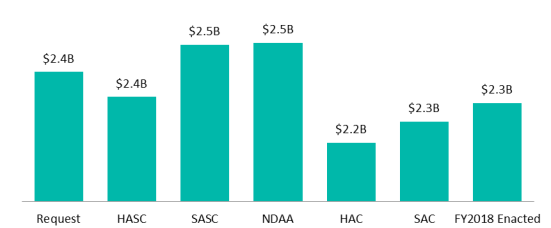 |
|
Source: H.Rept. 115-200, S.Rept. 115-125, H.Rept. 115-188, S.Rept. 115-130, and Joint Explanatory Statement to accompany H.R. 1625. Note: Column heights indicate numerical differences that may not be reflected in totals shown due to rounding. |
All congressional defense committees would have provided less than the $254 million the Administration requested for the Presidential Aircraft Recapitalization project at Joint Base Andrews, in MD. This capital intensive project would house two oversized Boeing 747-8 aircraft, replacing the current version of Air Force One (VC-25).
Most of the defense committees adapted their budget materials to account for the late USAF submission of detailed justification data that describe projects supporting the bed down of new KC-46A tanker aircraft, scheduled for delivery beginning in FY2020. The committees—with the exception of the SASC—adjusted their materials by including 15 additional projects at Travis Air Force Base, CA and at McGuire-Dix-Lakehurst, NJ. Generally, the committees made no significant adjustments to the administration's topline request ($269 million) for the KC46A infrastructure.92
The defense committees split by chamber on how to fund the Administration's request for Air Force ERI, which represented roughly half of the service's entire OCO MILCON request. House committees would have significantly reduced the amounts provided, primarily by reducing funds for projects in Hungary, Slovakia, and Norway. Those in the Senate would have fully funded the Administration's topline request. Uniquely, the SASC proposed moving all ERI funds from the OCO account to the base (depicted below in dark).
|
Figure 20. Air Force ERI Funding for Military Construction Activities |
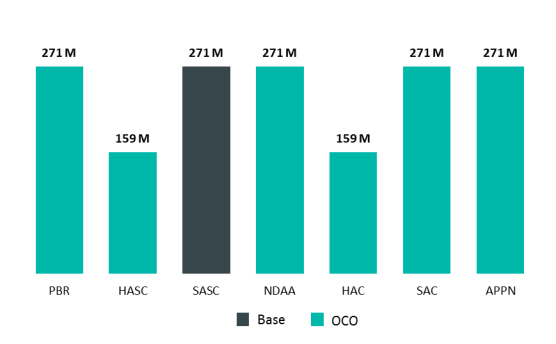 |
|
Sources: H.Rept. 115-200, S.Rept. 115-125, H.Rept. 115-188, S.Rept. 115-130, and Joint Explanatory Statement to accompany H.R. 1625. Notes: The SASC moved the Administration's ERI request of $271 million in OCO funds to the base account (shown in dark). All other committees recommended ERI funds remain in OCO. |
Authorization Actions
House Authorization
The House version of the FY2018 NDAA (H.R. 2810) as passed on July 14, 2017, would have authorized $2.4 billion for Air Force MILCON projects, $85 million below the Administration's request. While this topline is similar to the Administration's request, H.R. 2810 would have added 19 new projects to the Administration's request and altered more than half of the total number of projects.
Among the most significant changes to the President's request that H.R. 2810 would have made is a $130 million reduction to the Presidential Aircraft Recapitalization project at Joint Base Andrews, MD. All Congressional defense committees reduced this project. In report language, the HASC indicated that though it endorsed the total request ($254 million), it also "supports the authorization of appropriations in an amount equivalent to the ability of the department to execute in the year of the authorization for appropriations. For this project, the committee believes that DOD has exceeded its ability to fully expend the funding in fiscal year 2018."93
Other changes made by H.R. 2810 fall into several categories. The first of these, related to the bed down of KC-46As at Joint Base McGuire-Dix-Lakehurst and Travis Air Force Base beginning in FY2021,94 would have replaced a single budget line item with 15 projects of an equivalent amount ($269 million dollars). This change was made in response to new information provided by the Services.
A second category of changes would have altered the composition of the OCO account through a combination of transfers ($68 million shifted from the base account) and $112 million in cuts (primarily from ERI projects in Norway, Slovakia, and Hungary).
Authorizers would have made a third category of changes with the addition of roughly $156 million in new projects. More than half would have authorized new funding for Air Force Reserve and Air National Guard projects at nine installations, primarily for the construction of small arms ranges.95 The largest active component project within this category would have been the unfunded construction of a 288-room dormitory at Eglin Air Force Base, FL ($44 million).96
As noted above, H.R. 2810 would have stripped funding for all ERI projects from the Administration's FY2018 request by removing seven projects ($112 total) from installations in Rygge, Norway; Sliac and Malacky, Slovakia; and Kecskemet Air Base, Hungary. In report language, the committee included standard language to describe these reductions:
The Committee supports the requirements for this project and provides the full authorization.… However, the committee supports the authorization of appropriations in an amount equivalent to the ability of the department to execute in the year of the authorization of appropriations. For this project, the committee is concerned the Department may not be able to begin construction in fiscal year 2018….97
Senate Authorization
S. 1557, as reported by the committee on July 13, 2017, would have authorized $2.5 billion in appropriated amounts for Air Force military construction projects for FY2018, $92 million more than the Administration requested. Most of the additional amounts would have been directed to unfunded Air Force Reserve and Air National Guard projects.
|
Component |
Request |
SASC Changes |
SASC |
|
Air Force |
$2,217 |
-$43 |
$2,174 |
|
Air Force Reserve |
$64 |
$109 |
$172 |
|
Air National Guard |
$161 |
$26 |
$187 |
|
Total |
$2,442 |
$92 |
$2,534 |
Source: S.Rept. 115-125
S. 1557 would also have substantially altered Air Force OCO construction by shifting all 10 ERI projects to the base account ($271). Unlike the HASC, Senate authorizers would have fully funded the Administration's FY2018 ERI request.
Also unlike the House, Senate authorizers would not have included projects related to KC-46A operating bases at Joint Base McGuire-Dix-Lakehurst and Travis Air Force Base. The Administration's original request of $269 million for KC-46A Main Operating Base 4 at a single unspecified location was later itemized in supplementary justification data submitted to Congress in June 2017. The itemized list was not included in S. 1557 (S.Rept. 115-125). Senate authorizers would have reduced the aggregate amount requested by the Administration by $16 million.
Generally, the Senate measure made few topline reductions to the Administration's Air Force military construction request. The largest of these decreased funding for the Presidential Aircraft Complex at Joint Base Andrews, MD. For that project, the Senate measure provided $58 million, a reduction of nearly 80% from the Administration's original request of $254 million.98
Though S. 1557, as reported by the committee, would not have significantly altered the Administration's topline for Air Force construction, the bill did substantially change the contents of the President's proposal, adding more than a dozen new unfunded projects to the active, Reserve, and National Guard accounts. At the project level, the bill altered almost a third of the Administration's line item requests.
Table 19. SASC Changes: Non-ERI Air Force Military Construction, by Installation
(In millions of dollars)
|
Installation |
Request |
SASC Changed |
SASC |
|
Air Force |
$523 |
-$43 |
$481 |
|
Unspecified Worldwide Locations |
$0 |
$56 |
$56 |
|
Eglin AFB, FL |
$0 |
$44 |
$44 |
|
Little Rock AFB, AK |
$0 |
$20 |
$20 |
|
Tyndall AFB, FL |
$0 |
$17 |
$17 |
|
Altus AFB, OK |
$0 |
$16 |
$16 |
|
Kirtland AFB, NM |
$0 |
$9 |
$9 |
|
Wright-Patterson AFB, OH |
$0 |
$7 |
$7 |
|
KC-46A Main Operating Base 4 |
$269 |
-$16 |
$253 |
|
Joint Base Andrews, MD |
$254 |
-$196 |
$58 |
|
Air Force Reserve |
$0 |
$109 |
$109 |
|
Westover ARB, MA |
$0 |
$51 |
$51 |
|
Robins AFB, GA |
$0 |
$32 |
$32 |
|
Unspecified Worldwide Locations |
$0 |
$14 |
$14 |
|
Minneapolis-St Paul IAP, MN |
$0 |
$9 |
$9 |
|
NAS JRB Fort Worth, TX |
$0 |
$3 |
$3 |
|
Air National Guard |
$0 |
$26 |
$26 |
|
Hulman Regional Airport, IN |
$0 |
$8 |
$8 |
|
Tulsa International Airport, OK |
$0 |
$8 |
$8 |
|
Jackson International Airport, MS |
$0 |
$8 |
$8 |
|
Planning and Design |
$0 |
$2 |
$2 |
|
Total |
$523 |
$92 |
$615 |
Source: S.Rept. 115-125.
Notes: SASC shifted ERI funds the Administration requested in OCO to the base account. Those funds have been omitted from the table above to more clearly indicate projects not originally included in the President's request. (Including ERI funds would otherwise have appeared as 'new adds.')
NDAA Conference Outcome
The NDAA conference agreement (H.Rept. 115-404) authorized $2.5 billion for base and OCO military construction activities for the Air Force active and reserve components, or roughly $100 million above the President's request. Most additional amounts funded projects in the base account for the reserve component. The agreement designated $68 million for three non-U.S. projects (in Italy, Turkey, and Qatar) as OCO rather than base account funding.
Table 20. NDAA Military Construction Changes to the Administration's Air Force Request
(In millions of dollars)
|
Request |
NDAA Changed |
NDAA |
|
|
TITLE I - DEPARTMENT OF DEFENSE |
$327 |
$39 |
$366 |
|
Consolidated Mission Complex Phase 2 (Robins AFB, GA) |
$0 |
$32 |
$32 |
|
Consolidated Squadron Operations Facility (Al Udeid, Qatar) |
$15 |
-$15 |
$0 |
|
Construct Small Arms Range (Locations Shown Below) |
|||
|
Dane County Regional Airport/ Truax Field, WI |
$0 |
$8 |
$8 |
|
Hulman Regional Airport, IN |
$0 |
$8 |
$8 |
|
Jackson International Airport, MI |
$0 |
$8 |
$8 |
|
Tulsa International Airport, OK |
$0 |
$8 |
$8 |
|
Dormitories, 288 RM (Eglin AFB, FL) |
$0 |
$44 |
$44 |
|
Dormitory (Incirlik AB, Turkey) |
$26 |
-$26 |
$0 |
|
Dormitory—168 PN (Little Rock AFB, AK) |
$0 |
$20 |
$20 |
|
Fire Rescue Center (Altus AFB, OK) |
$0 |
$16 |
$16 |
|
Fire/Crash Rescue Station (Locations Shown Below) |
|||
|
Tyndall AFB, OK |
$0 |
$17 |
$17 |
|
Wright-Patterson AFB, OH |
$0 |
$7 |
$7 |
|
Guardian Angel Operations Facility (Aviano AB, Italy) |
$27 |
-$27 |
$0 |
|
Indoor Small Arms Range (Minneapolis-St Paul IAP, MN) |
$0 |
$9 |
$9 |
|
Munitions Training/Admin Facility (NAS JRB Fort Worth, TX) |
$0 |
$3 |
$3 |
|
Planning and Design (Worldwide Unspecified) |
$5 |
$72 |
$77 |
|
Presidential Aircraft Recapitalization Complex (Joint Base Andrews, MD) |
$254 |
-$154 |
$100 |
|
Replace Fire Station 3 (Kirtland AFB, NM) |
$0 |
$9 |
$9 |
|
TITLE IV - OVERSEAS CONTINGENCY OPERATIONS |
$0 |
$68 |
$68 |
|
Consolidated Squadron Operations Facility (Al Udeid, Qatar) |
$0 |
$15 |
$15 |
|
Dormitory (Incirlik AB, Turkey) |
$0 |
$26 |
$26 |
|
Guardian Angel Operations Facility (Aviano AB, Italy) |
$0 |
$27 |
$27 |
|
Total |
$327 |
$107 |
$434 |
Source: H.Rept. 115-404, conference report to accompany H.R. 2810
Notes: Does not include a package of projects submitted as "KC-46A Main Operating Base 4" in the Administration's original budget submission. Additional justification documents were submitted by the Department of the Air Force in June 2017 that described 15 specific projects at Joint Base McGuire-Dix-Lakehurst and Travis AFB. The House and Senate agreed to authorize $261 million, or $8 million less than the Air Force amended request.
The largest single change in the conference agreement was the reduction of $154 million authorized for the construction of a large hangar (and associated facilities) to support two new Presidential aircraft (Air Force One). In routine language, the conferees affirmed the project requirement but declined to authorize the full amount for FY2018 stating, "For this project, the conferees believe that the Department of defense has exceeded its ability to fully expend the funding in fiscal year 2018."99
Appropriations Actions
House Appropriations Committee Actions
The House version of the FY2018 Military Construction, Veterans Affairs, and Related Agencies Appropriations Act (Division C of H.R. 3219) would have appropriated $2.2 billion for Air Force active, National Guard, and Reserve military construction. This was $242 million less than the Administration's FY2018 request. Unlike authorizers in both chambers, House appropriators would not have provided additional amounts for Air Force Reserve and Guard unfunded projects.
House appropriators would have made the largest reduction ($124 million) to the Administration's request for construction of an Air Force One hangar replacement complex (see above).100 The current aircraft, a militarized version of the Boeing 747 (VC-25A), will reach the end of its life cycle by 2020. Its replacement, a Boeing 747-8, is larger and heavier than its predecessor.
Appropriators would have made most of the remaining reductions—roughly $112 million—to the OCO ERI account by eliminating airfield upgrades and infrastructure projects at locations in Hungary, Norway, and Slovakia.
In response to new information provided by the Air Force after the President's Budget submission, House appropriators shifted $269 million from Air Force worldwide unspecified accounts to locations in New Jersey (Joint Base McGuire-Dix-Lakehurst) and California (Travis Air Force Base) to support the bed down of KC-46A Tanker Aircraft.101 The committee's accounting adjustments for this new information did not alter the topline. Most of the other congressional defense committees made similar changes to account for the most recent information.
The Air Force has projected that the delivery of the tanker aircraft will begin in the second quarter of FY2020. However, in report language, the committee expressed concern that the Air Force had outlined an inadequate infrastructure strategy to support new mission requirements and cautioned that construction deficits at Pease Air National Guard Base and Seymour Johnson Air Base could lead to delays in fielding the systems.102
House appropriators made no changes to Air Force Reserve or Guard construction projects.
Senate Appropriations Committee Actions
S. 1557, as reported by the committee, would have appropriated $2.3 billion for Air Force military construction projects, a reduction of $170 million from the Administration's request. Senate appropriators, like their House counterparts, declined to add additional amounts for Air Force Reserve and Air National Guard unfunded projects. S. 1557 effectively would have made only two changes to the President's request.
First, S. 1557 would have appropriated $100 million for the Presidential Aircraft Recap Project, $154 million less than the Administration's requested amount. As indicated in previous sections, all congressional defense committees would have provided less than the President's full request for this capital intensive project, due to concerns related to the department's ability to expend appropriated funds.103
Second, Senate appropriators, like those in the House, would have shifted $269 million in funds for support of the bed down of KC-46A aircraft. The project, which the Administration first represented as aggregated line item at an unspecified location, was later altered to an itemized project list for construction at Travis Air Force Base, CA and Joint Base McGuire-Dix-Lakehurst, NJ. Appropriators would have authorized $254 million—$16 million less than the total amount the Administration requested—for the KC-46A projects involved.
Enacted Appropriations
The FY2018 Military Construction appropriations bill (Division J. of P.L. 115-141) as enacted provided $2.3 billion in appropriated amounts for Air Force base and OCO military construction projects, or $107 million less than the Administration's initial request. All reductions made by appropriators applied to the active Air Force, while the Reserve and Guard each received an additional $10 million in funding for minor military construction.
Among the largest changes the enacted legislation made was a 50% reduction of funds provided for construction of a Presidential aircraft complex at Joint Base Andrews, MD. The $254 million project, detailed in earlier sections, support two new Boeing 747-8 Presidential aircraft, which are anticipated to be larger and heavier than their predecessors.104
|
Figure 21. Presidential Aircraft Recap Complex: FY2018 Changes, by Defense Committee |
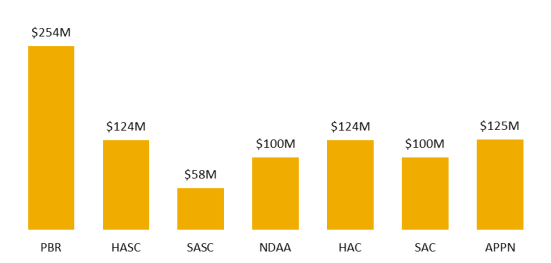 |
|
Sources: H.Rept. 115-200, S.Rept. 115-125, H.Rept. 115-188, S.Rept. 115-130, and Joint Explanatory Statement to accompany H.R. 1625. Note: Column heights indicate numerical differences that may not be reflected in totals shown due to rounding. |
As described in previous sections, in June 2017 the Air Force modified its submission for projects related to the KC-46A tanker aircraft basing. The change was not at first incorporated into congressional deliberations, and the project listed as single line item ($269 million). The apparent reduction of $269 million in the final appropriations bill is not an actual reduction, but is noted in the accompanying explanatory statement as
The recommended funding is provided under Travis Air Force Base, CA and Joint Base McGuire-Dix-Lakehurst, NJ as determined by the Secretary of the Air Force.105
The final appropriated amount for KC-46A related projects does, however, include a real reduction of roughly $8 million for several projects at Travis Air Force Base, including interior improvements in support of KC-46A squadron operations ($6.4 million) and the renovation of an existing fuel cell maintenance hangar ($1.4 million). Both of these projects received no funding in the final appropriations bill.
In addition to the funding changes outlined above, appropriators shifted significant funds ($68 million) from the base to the OCO account. These included projects in Italy (Guardian Angel Operations Facility, $27.3 million), Qatar (Consolidated Squadron Operations Facility, $15 million), and Turkey (Dormitory, $26 million). The move was not accompanied by any alterations to the original amount.
The following table summarizes military construction project funds appropriated for the Air Force, by location.
|
Project Location |
FY2018 Enacted |
Percentage of Total |
|
Worldwide Unspecified |
$300.9 |
12.9% |
|
United Kingdom |
$182.6 |
7.8% |
|
Alaska |
$168.9 |
7.2% |
|
Texas |
$156.6 |
6.7% |
|
New Jersey |
$146.5 |
6.3% |
|
Jordan |
$143.0 |
6.1% |
|
Maryland |
$142.4 |
6.1% |
|
California |
$129.7 |
5.6% |
|
Colorado |
$89.0 |
3.8% |
|
Florida |
$79.8 |
3.4% |
|
Australia |
$76.0 |
3.3% |
|
Luxembourg |
$67.4 |
2.9% |
|
Wyoming |
$62.0 |
2.7% |
|
Nevada |
$61.0 |
2.6% |
|
Hungary |
$55.4 |
2.4% |
|
Turkey |
$48.7 |
2.1% |
|
New Mexico |
$46.3 |
2.0% |
|
Slovakia |
$46.0 |
2.0% |
|
Utah |
$31.1 |
1.3% |
|
Italy |
$27.3 |
1.2% |
|
North Dakota |
$27.0 |
1.2% |
|
Tennessee |
$25.0 |
1.1% |
|
Massachusetts |
$21.4 |
0.9% |
|
Oregon |
$18.5 |
0.8% |
|
Kansas |
$17.5 |
0.7% |
|
Ohio |
$15.0 |
0.6% |
|
Qatar |
$15.0 |
0.6% |
|
Iceland |
$14.4 |
0.6% |
|
Estonia |
$13.9 |
0.6% |
|
Mariana Islands |
$12.9 |
0.6% |
|
South Dakota |
$12.0 |
0.5% |
|
Norway |
$10.3 |
0.4% |
|
Missouri |
$10.0 |
0.4% |
|
Georgia |
$9.8 |
0.4% |
|
Kentucky |
$9.0 |
0.4% |
|
Connecticut |
$7.0 |
0.3% |
|
New York |
$6.8 |
0.3% |
|
North Carolina |
$6.4 |
0.3% |
|
Hawaii |
$5.5 |
0.2% |
|
Guam |
$5.2 |
0.2% |
|
Oklahoma |
$4.9 |
0.2% |
|
Latvia |
$3.9 |
0.2% |
|
Romania |
$3.0 |
0.1% |
|
Total |
$2334.9 |
100.0% |
Sources: H.R. 1625 (P.L. 115-141); Joint Explanatory Statement to accompany H.R. 1625.
Family Housing
President's Request
The Administration requested $1.4 billion for military family housing appropriations in FY2018. Most of this amount would have funded Operation and Maintenance expenses related to leasing, utilities, maintenance, furnishings, privatization, and related expenses intended to deliver suitable accommodation to military personnel and their families ($1 billion).
Construction of family housing units at specified locations represents a quarter of the total amount ($351 million). A relatively small proportion ($3 million) would also have been appropriated for family and unaccompanied housing improvement funds (described in following sections).
|
Figure 22. Major Elements of the FY2018 Family Housing Request |
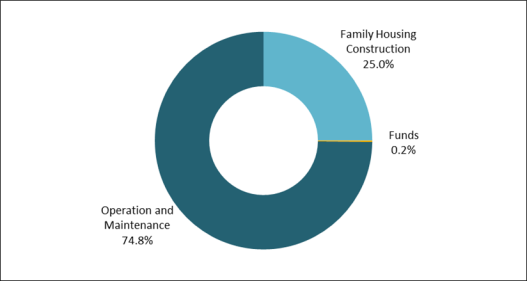 |
|
Sources: H.Rept. 115-200, S.Rept. 115-125, H.Rept. 115-188, S.Rept. 115-130, and Joint Explanatory Statement to accompany H.R. 1625. Notes: Funds category includes family housing improvement funds; DOD Unaccompanied Housing Improvement Fund and DOD Family Housing Improvement Fund. |
Family housing construction projects specified in the PBR were generally located overseas, with the largest projects in Germany (South Camp Vilseck), Guam (NSA Anderson), and South Korea (Camp Humphries).
Table 22. Family Housing Military Construction Projects in the Administration's FY2018 Request
(In millions of dollars)
|
State/Country |
Installation |
Requested |
|
Germany |
South Camp Vilseck |
$56.6 |
|
Mariana Islands (Guam) |
NSA Anderson |
$40.9 |
|
South Korea |
Camp Humphries |
$34.4 |
|
Italy |
Unspecified Planning & Design |
$33.6 |
|
Marshall Islands |
Kwajalein Atoll |
$31.0 |
|
Unites States |
Natick, MA |
$21.0 |
|
Unites States |
Fort Gordon, GA |
$6.1 |
|
Bahrain |
Unspecified |
$2.1 |
|
Total |
$225.7 |
Source: CRS analysis of Congressional Summary documents (H.Rept. 115-200, S.Rept. 115-125, H.Rept. 115-188, S.Rept. 115-130).
Notes: Table indicates only projects at specified locations. It omits $125.7 million in family housing construction at unspecified locations: $3.3 million for housing funds (no associated location), and $1.1 billion in Operation and Maintenance (no specified location).
Overview of Congressional Action
The final FY2018 NDAA (H.R. 2810) provided the full amount of the Administration's request and made no changes to individual projects. Among the authorizing congressional defense committees, only the SASC recommended altering the Administration's Family Housing request for specified projects (a reduction of $72 million) by providing no funds for Army construction of 22 new family housing units in the Kwajalein Atoll ($31 million) and for replacement housing at the Navy's NSA Anderson, in Guam ($41 million).106
The Senate's recommendation to prohibit funds for these projects (Sec. 2844, S. 1519) and, in a related amendment, to require the Secretary of Defense to undertake a comprehensive review of family accompanied remote duty locations, reflected a concern over the added expense associated with such tours.
The final NDAA agreement amended the Senate's provision for this analysis and further stated
The conferees are concerned with the significant costs associated with maintaining accompanied tours at remote locations. The proposed new 52 family housing units on Kwajalein would cost over $1.3 million each. The proposed $250.0 million replacement hospital at Guantanamo Bay would cost $50.0 million per bed. Costs for school construction and support are also significantly higher at these remote locations than they are in the United States, which is a primary reason why locations such as Diego Garcia are unaccompanied.107
The final FY2018 Military Construction appropriation included $1.4 billion for Family Housing, or roughly $2.3 million less than the President requested. Among appropriators, only the SAC recommended reductions to funds requested by the Administration. These changes, which were included in the final FY2018 Military Construction appropriations legislation as enacted, included a reduction of $2.2 million for leasing and services at unspecified locations.
While appropriators provided the full amount for expenses related to family housing construction on Kwajalein Atoll, they too expressed concern over project details, and inserted the following provision that made funds conditional on certification by the Secretary of the Army:
Provided, That none of the funds provided under this heading for family housing construction may be expended for family housing improvements on Kwajalein Atoll until the Secretary of the Army certifies to the congressional defense committees that the new housing units represent the best value to the taxpayer and that no reasonable alternatives exist at a lower cost.108
FY2018 Family Housing Request: Context
DOD chiefly relies on nearby communities to provide appropriate housing for its military (and eligible civilian) families, defraying their rental expenses with a Basic Allowance for Housing (BAH) paid from each service component's military personnel account. However, where no adequate options exist in the private sector, DOD provides government owned or leased accommodations.109 The Administration's FY2018 request represented roughly 14% of all MILCON appropriations, an amount roughly consistent with the last decade of spending. Historically, Family Housing has consisted of a much larger share—in some years rising to almost 50% of all appropriated totals.
Overseas Contingency Operations (OCO) Funding
The following section provides an overview of the Administration's FY2018 OCO request for military construction projects, follows selected congressional action, and summarizes enacted totals. Unless otherwise specified, the amounts shown below combine all service components. OCO and European Reassurance Initiative are treated separately.
President's Request
In its original budget submission to Congress, the Trump Administration requested $638 million in Overseas Contingency Operations funding for MILCON appropriations in FY2018. Nearly half ($306 million) funded European Reassurance Initiative (ERI) construction projects.
The largest single component of the ERI request supported planning and design projects at unspecified locations ($93 million). Other notable ERI projects included an airfield infrastructure warehouse in Sanem, Luxembourg ($67 million), airfield upgrades and storage facilities at Kecskemet Airbase, Hungary, and airfield construction at several locations in Slovakia ($46 million).110
The Administration's non-ERI request ($331 million) included a relatively small number of relatively expensive projects; the construction of a new airfield in Jordan ($143 million), an enlisted barracks at Guantanamo Bay ($115 million), and security upgrades at Incirlik Air Base in Turkey ($22 million).
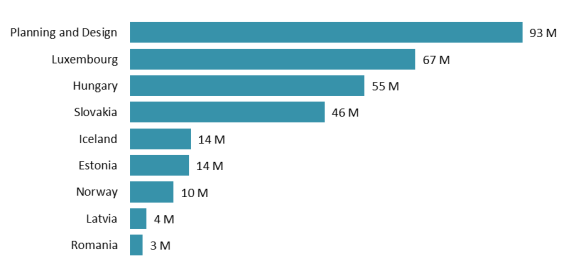 |
|
Source: CRS Analysis, Compiled from DOD Comptroller, Military Construction, Family Housing, and Base Realignment and Closure Program (C-1) |
Congressional Action
Congress generally funded OCO (and ERI) projects in amounts that exceeded the Administration's FY2018 topline request. However, authorizers and appropriators often proposed rebalancing projects between the base and OCO accounts, in some cases, shifting a hundred million dollars or more.111 The SASC was unique for recommending all ERI related construction projects ($307 million) be moved into the base account (Title I) from OCO (Title IV). In general, congressional defense committee recommendations would have provided funding that matched or exceeded the topline amount requested by the Administration for FY2018.
|
Figure 25. FY2018 OCO and ERI Military Construction Activities Funding (In millions of dollars) |
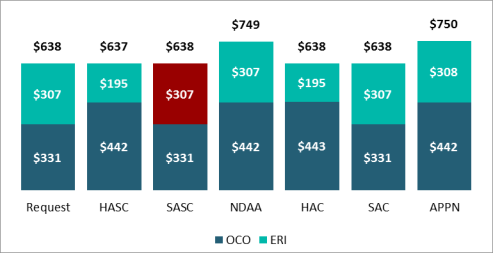 |
|
Sources: H.Rept. 115-200, S.Rept. 115-125, H.Rept. 115-188, S.Rept. 115-130, and Joint Explanatory Statement to accompany H.R. 1625. Note: SASC provided funding for ERI projects, but funded them in the base account. This has been indicated on the graph in red. |
Congress authorized and appropriated full funding for the Administration request for construction projects related to ERI. The following congressional action table provides an overview of congressional changes made to projects that were identified as related to the Initiative.
|
Requested |
HASC Changed |
SASC Changed |
NDAA Changed |
HAC Changed |
SAC Changed |
APPN Changed |
|
|
Base |
|||||||
|
ERI Projects |
— |
— |
+$307 |
— |
— |
— |
— |
|
OCO |
|||||||
|
ERI Projects |
$307 |
-$112 |
-$307 |
— |
-$112 |
— |
+$1 |
Source: H.Rept. 115-200, S.Rept. 115-125, H.Rept. 115-188, S.Rept. 115-130, and Joint Explanatory Statement to accompany H.R. 1625.
The Administration's request for OCO Planning and Design funds, which represent nearly a quarter of all amounts within the OCO account, attracted some Congressional notice.112 In report language, the HAC expressed concerns with DOD's process for reviewing OCO MILCON requests that no longer followed the Department's required planning, programming, budgeting, and execution (PPBE) guidelines. It directed that the Secretary of Defense submit a future year defense program for OCO projects with each annual budget request (beginning in FY2018), a provision that was narrowed during conference negotiations to include only ERI projects before being adopted into final legislation.113 House appropriators also directed that, beginning in FY2019, the department include all requests for planning and design funds only in the base request, a provision that was not adopted.114
FY2018 BRAC
With no Base Realignment and Closure (BRAC) round authorized or underway, the primary purpose of continuing BRAC appropriations is to fund the environmental remediation necessary to permit the transfer of title to BRAC real property from the federal government to other parties.115
For FY2018, the President submitted a request of $256 million for BRAC-related activities. Congress has appropriated $310 million, or roughly $54 million (20%) more than the Administration requested.
Defense committees of jurisdiction in the Senate (SASC, SAC) generally recommended fully funding the Administration's request. Authorizing and appropriating committees in the House, however, recommended Congress provide an additional $35 million in excess of the Administration's request, primarily for the purpose of accelerating environmental remediation efforts at closed BRAC installations.
|
Figure 26. FY2018 BRAC Account: Request, Authorizations, and Appropriations (In millions of dollars) |
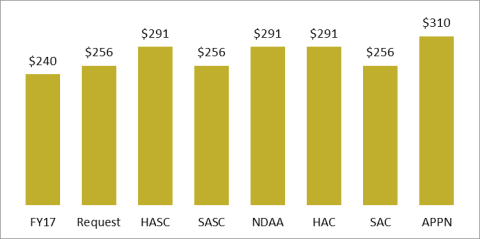 |
|
Source: H.Rept. 115-200, S.Rept. 115-125, H.Rept. 115-188, S.Rept. 115-130, and Joint Explanatory Statement to accompany H.R. 1625. |
In report language, the HASC noted the Department's goal of reaching 95% "response complete"—a status indicating remediation milestone goals have been met—by the end of FY2021 for more than 34,000 sites that include BRAC locations. The committee further directed DOD to report on efforts to achieve 100% "status "complete" for these H.R. 1625 sites.116
Appropriators expressed similar concerns in the joint explanatory statement that accompanied the enacted FY2018 Military Construction appropriations legislation (Division J of H.R. 1626/ P.L. 115-141).
Accelerated cleanup.—The agreement includes additional funding to accelerate environmental remediation at installations closed during previous Base Realignment and Closure (BRAC) rounds. Priority should be given to those sites with newly identified radiological cleanup cost. There are many factors hindering the cleanup of BRAC sites. However, strategic investments can lead to quicker clean-ups and faster turnover of DOD property to the local community. Therefore, the Department is directed to submit to the congressional defense committees a spend plan for the additional BRAC funds not later than 30 days after enactment of this Act.117
Congressional Action on BRAC
Legislative language prohibiting the use of funds for the purpose of a new BRAC round was included in final authorizing and appropriating legislation.
- FY2018 NDAA (H.R. 2810): The NDAA conference agreement reflected identical provisions in the House and Senate versions of the bill that stated, "Nothing in this act shall be construed to authorize an additional Base Realignment and Closure (BRAC) round."118
- FY2018 Defense Appropriations (H.R. 1625, Division J, Section 8120): "None of the funds made available by this Act may be used to propose, plan for, or execute a new or additional base Realignment and Closure (BRAC) round."
The Administration strongly objected to such prohibitions, arguing a new BRAC round was necessary "so that DOD can ensure it is not wasting resources on unneeded infrastructure."119 Congressional advocates of the process made several unsuccessful attempts to initiate a new round.
On January 31, 2017, Representative Adam Smith submitted H.R. 753, the "Military Infrastructure Consolidation and Efficiency Act of 2017," which would have reauthorized a BRAC process to begin in FY2019 that closely adhered to the established template of earlier rounds. That bill was last referred to the subcommittee on Readiness in February, 2017.
A second proposal, drafted by Senator John McCain and proposed as an amendment to the annual National Defense Authorization Act for FY2018 (H.R. 2810),120 would have taken a different approach. By omitting the appointment of a BRAC Commission charged with reviewing recommendations made by the Secretary of Defense, Senator McCain's amendment would have effectively omitted what long-time observers have considered the basic tenets of the BRAC process: third party appraisal by an independent commission and expansive opportunities for public comment by affected communities and other stakeholders.
Appendix A. Summary of Report Methodology
Historical and Regional Analysis
The historical and regional data used in this report was derived from DOD Comptroller budget documents generally regarded as the most authoritative open source available for analyzing MILCON expenditures in detail. Since FY2001, the Comptroller has posted this data in Excel format for public use, however, the style, spelling, format, and content have varied from year to year. The graphic below illustrates a selected list of (simplified) fields the Comptroller has either included or omitted from year to year.
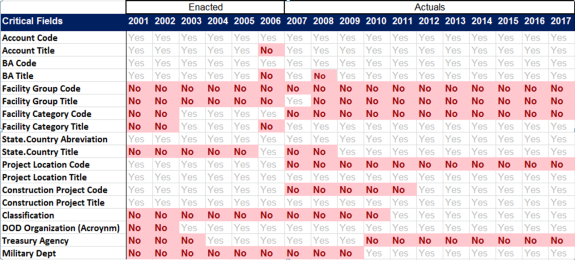 |
|
Source: CRS analysis of Department of Defense Comptroller C-1 data (Military Construction, Family Housing, and Base Realignment and Closure Program). |
Data elements contained in publicly-available Comptroller spreadsheets frequently contain labeling omissions, discrepancies, and other variations or errors, particularly in years prior to FY2008. Wherever possible, CRS has attempted to correct for these data anomalies by relying on numerical codes and keywords contained in associated fields. For example, to establish Classified Construction CRS identified records with the word classified in either the State/Country, or Construction Project Title columns of the compiled dataset. To identify minor construction, CRS relied on variations of the key phrase Minor Const in the fields, BA Title, and Construction Project Title, omitting BRAC related (and blank) records.121
To identify regional trends in military construction activities, CRS merged project level country data with various geoschemes. For example, the U.N. regional and sub-regional classification system was used for this purpose, as well as a compiled list of countries-by-COCOM.122
Appendix B. Additional Projects Requested
In FY2018, the Administration's $10.1 billion request for military construction appropriations was amended a number of times to include approximately $920 million for additional projects in response to natural disasters and provocative actions taken by North Korea. The additional requests are colloquially referred to as either hurricane relief or the missile amendment.
The table below summarizes these additional projects by state, location, facility category title, and organization for the Army National Guard (ARNG), Navy/Marine Corps (N/MC), and Missile Defense Agency (MDA, Defense-Wide).
Table B-1. FY2018 Military Construction Projects Added to the Administration's MILCON Request
(In millions of dollars)
|
Army National Guard |
Navy/Marine Corp |
Defense-Wide, Missile Defense Agency |
Total |
|
|
DISASTER RELIEF (Total) |
$519 |
$202 |
$721 |
|
|
FLORIDA |
$129 |
$129 |
||
|
Key West |
||||
|
Aircraft Maintenance Facilities |
$52 |
$52 |
||
|
Installation Support Facilities |
$9 |
$9 |
||
|
Other Improvements |
$68 |
$68 |
||
|
PUERTO RICO |
$458 |
$458 |
||
|
Arroyo |
||||
|
Training Buildings |
$32 |
$32 |
||
|
Camp Santiago |
||||
|
Admin Buildings |
$56 |
$56 |
||
|
Detached Unaccom. Personnel Housing |
$106 |
$106 |
||
|
Electric Power Transmission & Distribution Lines |
$32 |
$32 |
||
|
Impact, Maneuver, and Training Areas |
$53 |
$53 |
||
|
Misc. Items & Equip Maint. Facilities |
$10 |
$10 |
||
|
Other Operational |
$43 |
$43 |
||
|
Unaccomp. Personnel Housing Mess |
$23 |
$23 |
||
|
Gurabo |
||||
|
Tank and Automotive Maintenance |
$52 |
$52 |
||
|
San Juan |
||||
|
Aviation Navigation & Traffic Aids Facilities |
$51 |
$51 |
||
|
TEXAS |
$58 |
$58 |
||
|
Corpus Christi |
||||
|
Operational Support Buildings |
$5 |
$5 |
||
|
Training Buildings |
$53 |
$53 |
||
|
VIRGIN ISLANDS |
$23 |
$23 |
||
|
Bethlehem Military Compound |
||||
|
Electric Power Source |
$4 |
$4 |
||
|
Nazareth |
||||
|
Tank and Automotive Maintenance |
$19 |
$19 |
||
|
Planning & Design (Unspecified) |
$38 |
$15 |
$53 |
|
|
Missile Supplemental (Total) |
$200 |
$200 |
||
|
ALASKA |
||||
|
Fort Greely |
$200 |
$200 |
||
|
Total |
$519 |
$202 |
$200 |
$921 |
Source: See Joint Explanatory Statement to accompany H.R. 1625.
Notes: Army National Guard (ARNG); Navy and Marine Corps (N/MC); Missile Defense Agency (MDA).
The table below details the CRS account grouping shown in Table I. of this paper. The data is derived from the comparative statements of committee conference reports, which may vary organizationally, affecting the totals and subtotals they provide. The table is formatted hierarchically by Title, CRS Account Type Category, and Account designation.
|
TITLE I - DEPARTMENT OF DEFENSE |
||
|
Administrative Provisions |
||
|
42 USC 3374 (Sec. 128) |
||
|
Defense Access Roads Program (Sec.131) |
||
|
Family Housing Construction, Air Force (Sec. 126) |
||
|
Family Housing Construction, Army (Sec. 126) |
||
|
Family Housing Construction, Navy and Marine Corps (Sec. 126) |
||
|
Military Construction, Air Force (Sec. 125) |
||
|
Military Construction, Air Force (Sec. 127) (rescission) |
||
|
Military Construction, Air Force Reserve (Sec. 125) |
||
|
Military Construction, Air National Guard (Sec. 125) |
||
|
Military Construction, Army (Sec. 125) |
||
|
Military Construction, Army (Sec. 126) (rescission) |
||
|
Military Construction, Army National Guard (Sec. 125) |
||
|
Military Construction, Army Reserve (Sec. 125) |
||
|
Military Construction, Defense-Wide - Planning and Design (Sec. 127) |
||
|
Military Construction, Defense-Wide (Sec. 126) (rescission) |
||
|
Military Construction, Navy and Marine Corps (Sec. 125) |
||
|
Military Construction, Navy and Marine Corps (H. Sec. 126) (rescission) |
||
|
Military Construction, Navy and Marine Corps (Sec. 126) |
||
|
NATO Security Investment Program (Sec. 126) |
||
|
NATO Security Investment Program (Sec. 127) (rescission) |
||
|
Base Realignment and Closure |
||
|
Department of Defense Base Realignment and Closure Account |
||
|
Family Housing |
||
|
Department of Defense Family Housing Improvement Fund |
||
|
Family Housing Construction, Air Force |
||
|
Family Housing Construction, Army |
||
|
Family Housing Construction, Navy and Marine Corps |
||
|
Family Housing Operation and Maintenance, Air Force |
||
|
Family Housing Operation and Maintenance, Army |
||
|
Family Housing Operation and Maintenance, Defense-Wide |
||
|
Family Housing Operation and Maintenance, Navy and Marine Corps |
||
|
Military Construction |
||
|
Chemical demilitarization construction, Defense-Wide |
||
|
DoD Military Unaccompanied Housing Improvement Fund |
||
|
Military Construction, Air Force |
||
|
Military Construction, Air Force Reserve |
||
|
Military Construction, Air National Guard |
||
|
Military Construction, Army |
||
|
Military Construction, Army National Guard |
||
|
Military Construction, Army Reserve |
||
|
Military Construction, Defense-Wide |
||
|
Military Construction, Navy and Marine Corps |
||
|
Military Construction, Navy Reserve |
||
|
NATO |
||
|
North Atlantic Treaty Organization Security Investment Program |
||
|
TITLE IV - OVERSEAS CONTINGENCY OPERATIONS |
||
|
Administrative Provisions |
||
|
Military Construction, Air Force (Sec. 101, P.L. 115-31) (rescission) |
||
|
ERI |
||
|
Air Force |
||
|
Army |
||
|
Defense-Wide |
||
|
Navy |
||
|
OCO |
||
|
Air Force |
||
|
Air Force Reserve |
||
|
Air National Guard |
||
|
Army |
||
|
Army National Guard |
||
|
Army Reserve |
||
|
Defense-Wide |
||
|
Military Construction, Air Force (Sec. 101, P.L. 115-31) (rescission) |
||
|
Navy |
||
|
Navy Reserve |
